News
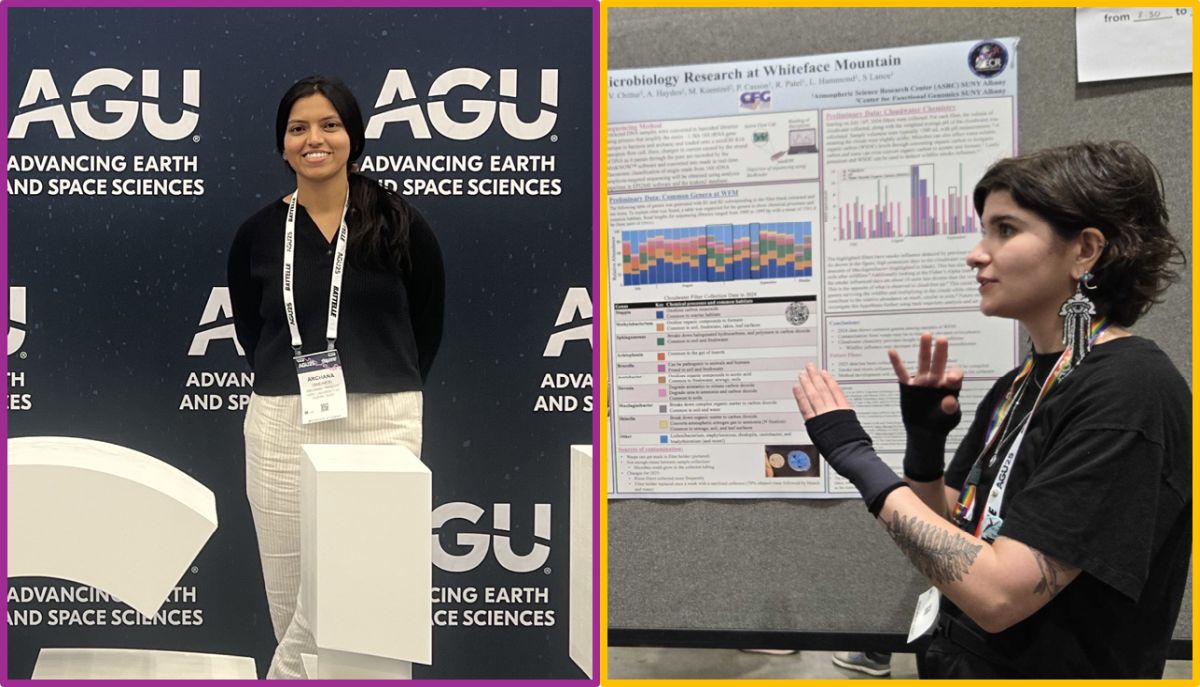
AGU Conference 2025Dec 19, 2025Sara Lombardo and Archana attended the annual American Geophysical Union (AGU) conference this year, presenting observations of microbial life and organic acids within cloud water samples collected at Whiteface Mountain, two distinct but complementary research areas. |

Stockholm University VisitDec 12, 2025I was privileged to be invited by Drs. Claudia Mohr and Paul Zieger to sit on the doctoral committee of their graduate student Fredrik Mattsson, who successfully defended his thesis on fog droplets as chemical reactors in the Environmental Sciences Dept at Stockholm University. As this was my first time visiting Sweden, I appreciated the opportunity to visit the labs there and meet with everyone in person. I also presented an overview of our recent work at Whiteface Mountain at a departmental seminar. So happy I could make it! |
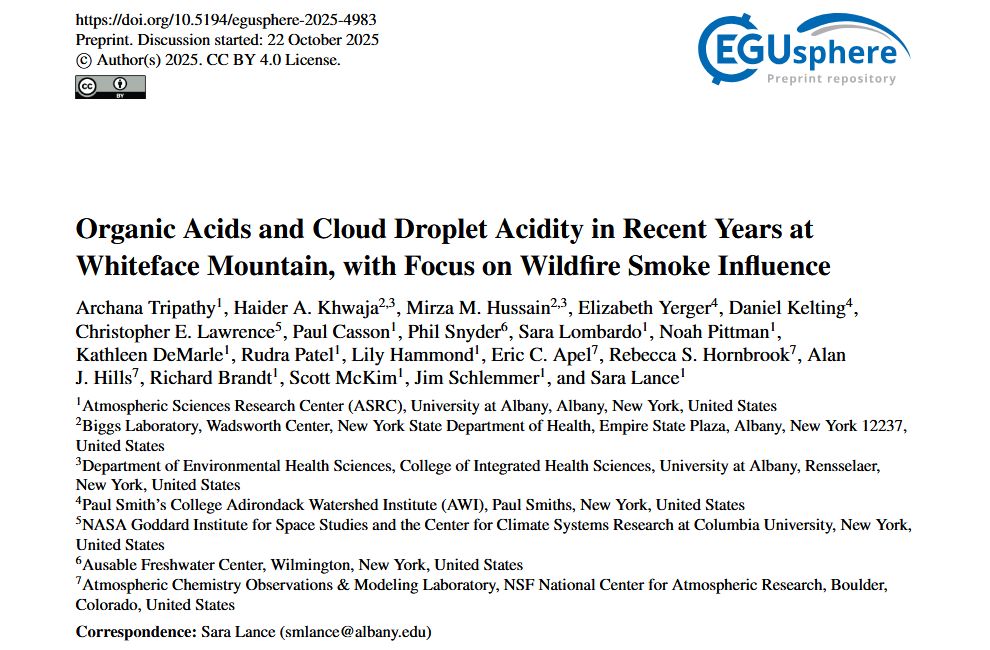
Archana's Paper in review at ACP!Oct 22, 2025Our paper describing seven years of cloud water chemical measurements from Whiteface Mountain (2018-2024) with a focus on low molecular weight organic acids: formate, acetate and oxalate, is under review for publication in the journal Atmospheric Chemistry and Physics (ACP). The paper highlights contributions of these organic acids to cloud droplet acidity and dissolved organic carbon, and contrasts fresh and aged wildfire smoke plumes from extreme smoke episodes impacting the northeast U.S. in the summers of 2021 and 2023. |
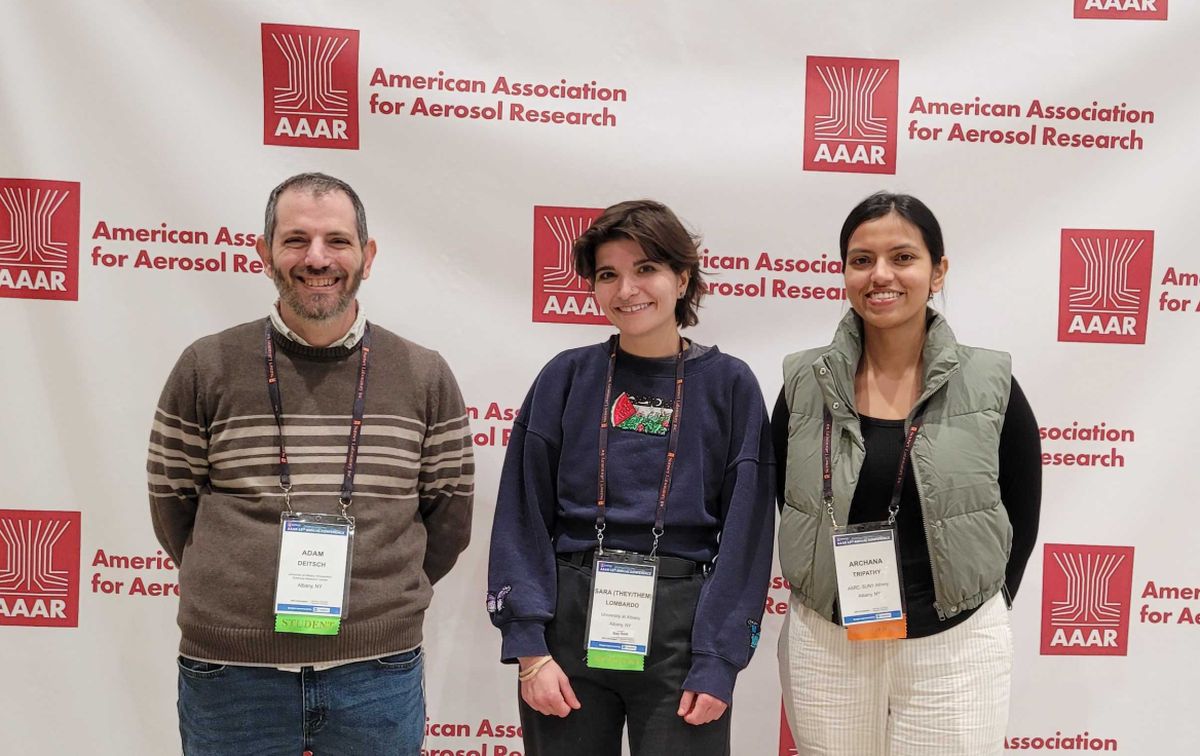
AAAR Conference 2025 in BuffaloOct 17, 2025The American Association for Aerosol Research (AAAR) held another great meeting, this time in our own backyard in Buffalo NY! Sara Lombardo presented a poster on their preliminary cloud microbiological analyses coupled with air quality datasets, Adam presented a poster on measurement of nanoplastic particles in an indoor environment (for which he won a student poster award!), and Archana presented an oral presentation on seven years of organic acid measurements in cloud water, highlighting the important role of wildfire smoke plumes. Archana also co-chaired the platform session: Ambient Aerosol Chemistry and New Particle Formation. |
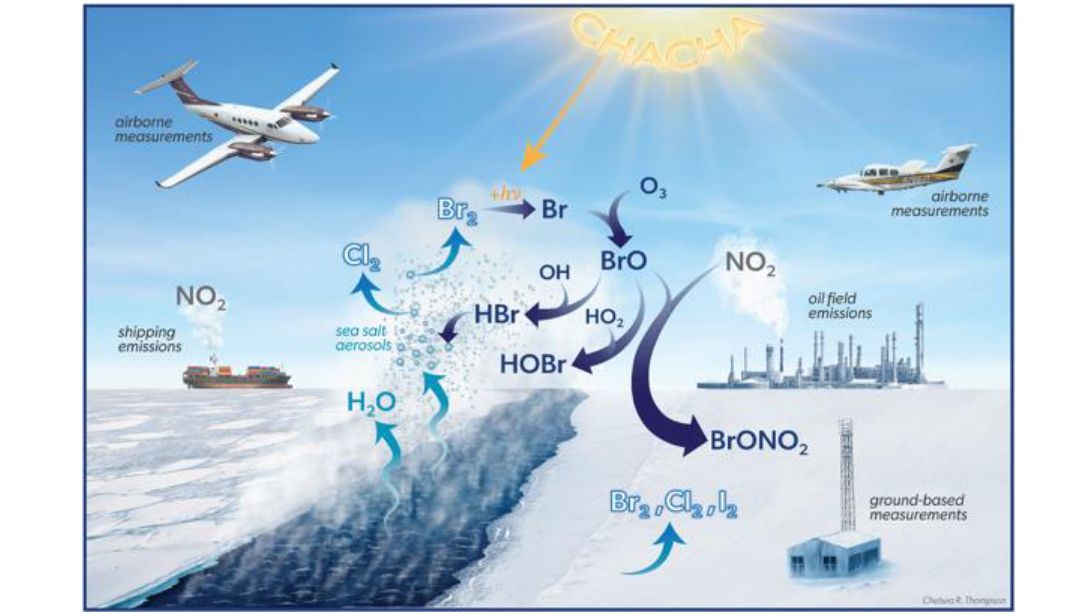
CHACHA Overview paper published in BAMSSep 23, 2025An overview of the 2022 CHemistry in the Arctic: Clouds, Halogens, and Aerosols (CHACHA) field campaign is now published in the Bulletin of the American Meteorological Society (BAMS), with spotlight article highlighting major findings to date and lead cloud formation photo from CHACHA highlighted on the cover of BAMS issue 11. Thanks to Jose Fuentes for leading the effort to get this paper published, and to Shep for sponsoring the BAMS cover photo! |
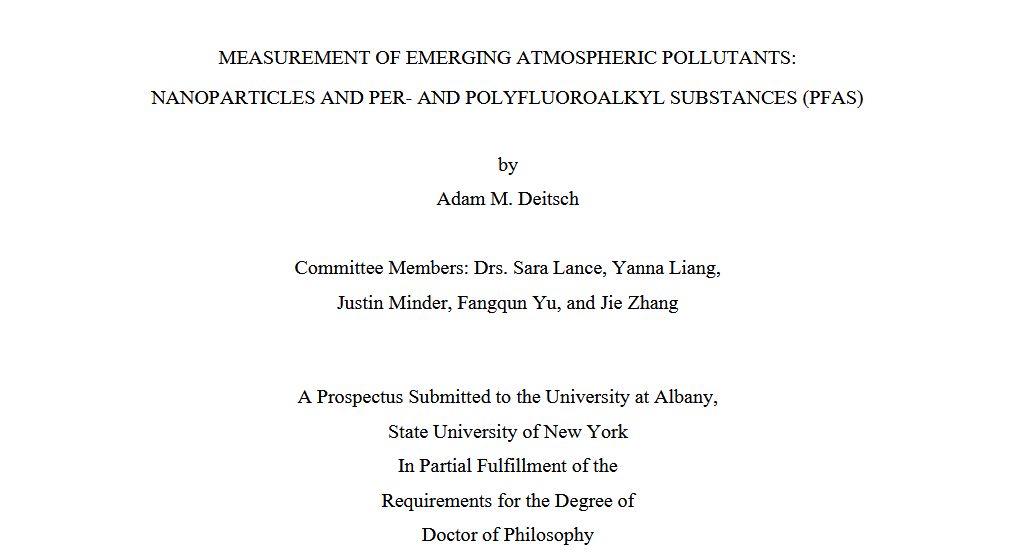
Adam passes his PhD prospectusAug 15, 2025Adam Deitsch passed his oral qualifying exam. The committee (comprised of Jie Zhang, Fangqun Yu, Justin Minder, Yanna Liang and I) found no major deficiencies in his prospectus or research plan. This is the last major milestone in the PhD degree program until the dissertation and defense. |
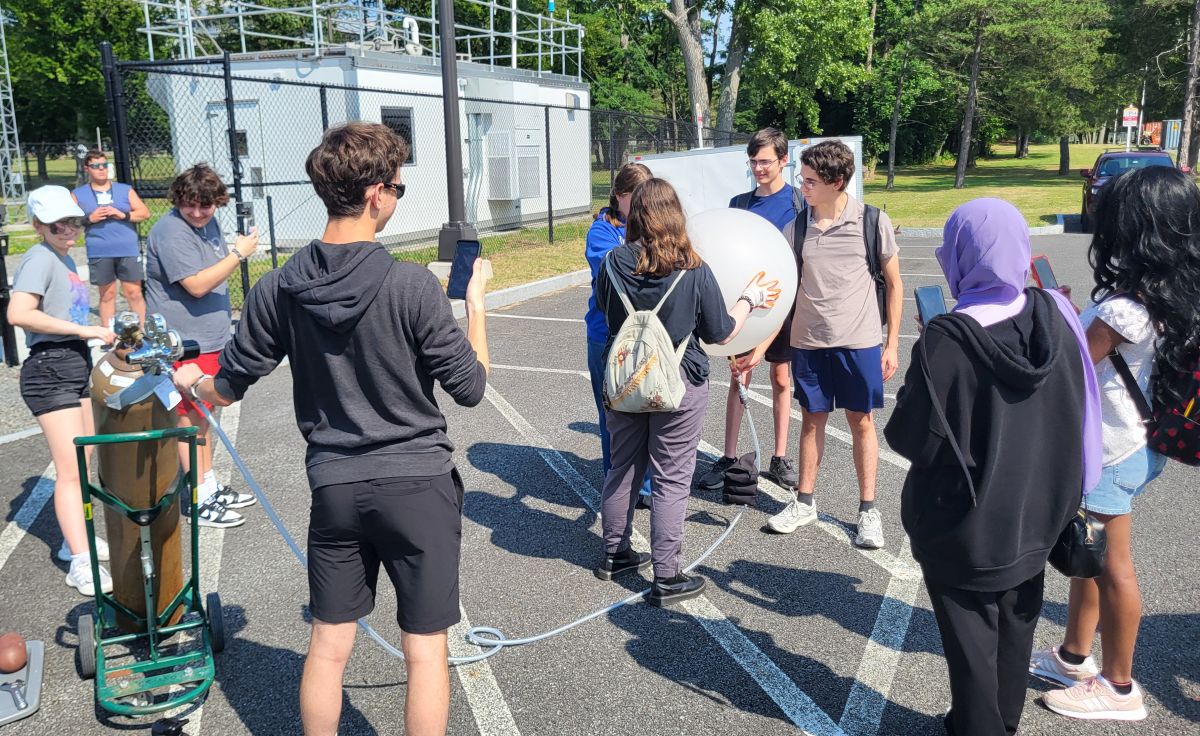
2025 Summer CampAug 1, 2025Justin Minder and I wrapped up our fifth UAlbany Weather, Climate & Chemistry Camp, a free summer day camp for high school students (Jul 23-Aug 1, 2025). We had 12 students participating this year from a variety of school districts in NYS. As in past years, students were exposed to a wide range of subjects relating to weather, climate and chemistry, and we owe a debt of gratitude to all the grad students, faculty and staff who volunteered their time to give these students a peek into their worlds. Also like last year, the heat wave and heavy smoke haze encountered during the camp from wildfires burning in Canada allowed us to showcase some of the air quality and weather phenomena highlighted in our camp curricula. |
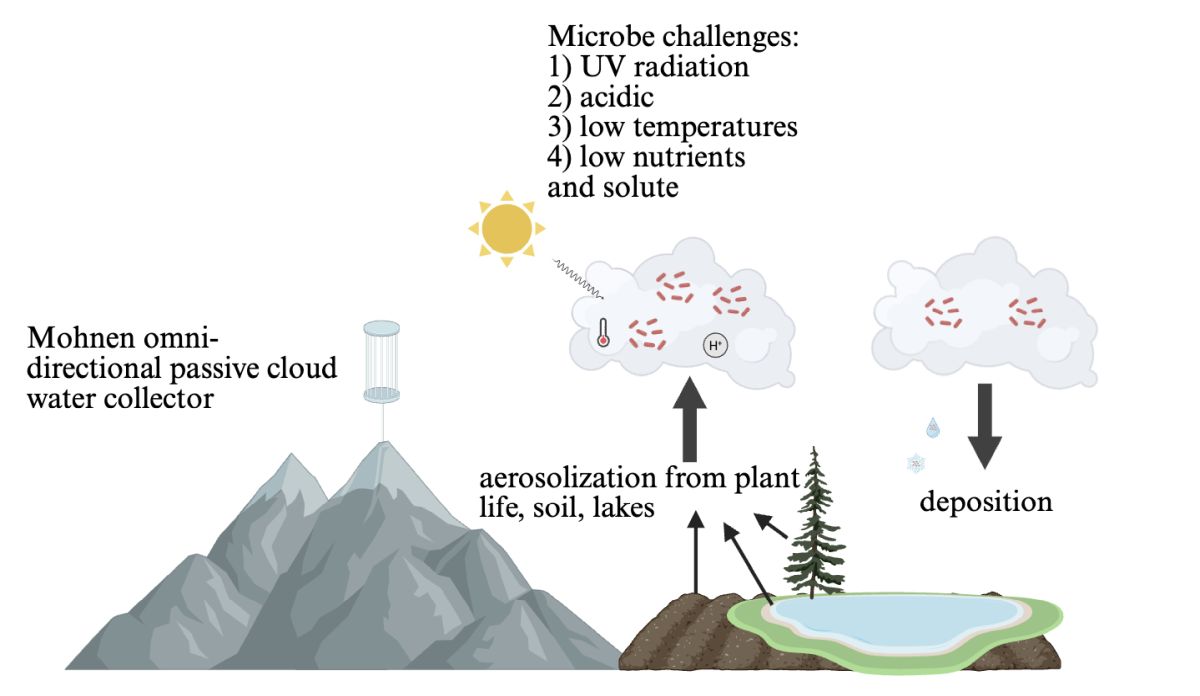
Sara is awarded a NASA FINESST Fellowship!Jul 8, 2025Sara Lombardo received notice that their proposal, 24-EARTH24-0510: Microbial and Chemical Composition of Summer Clouds at Whiteface Mountain, with a Focus on Wildfire Smoke and Health Impacts, was selected for a NASA graduate fellowship, designed to cover graduate student stipend and tuition for up to 3 years. This year was even more competitive than usual and only the top 10% of proposals submitted to the Earth Science category were selected (55 proposals selected out of 565 proposals submitted)! Sara created this drawing using BioRender to highlight some of the processes thought to be involved in atmospheric microbial loadings and viability. Sara also discusses this research on a UAlbany 5Q's webpage. |
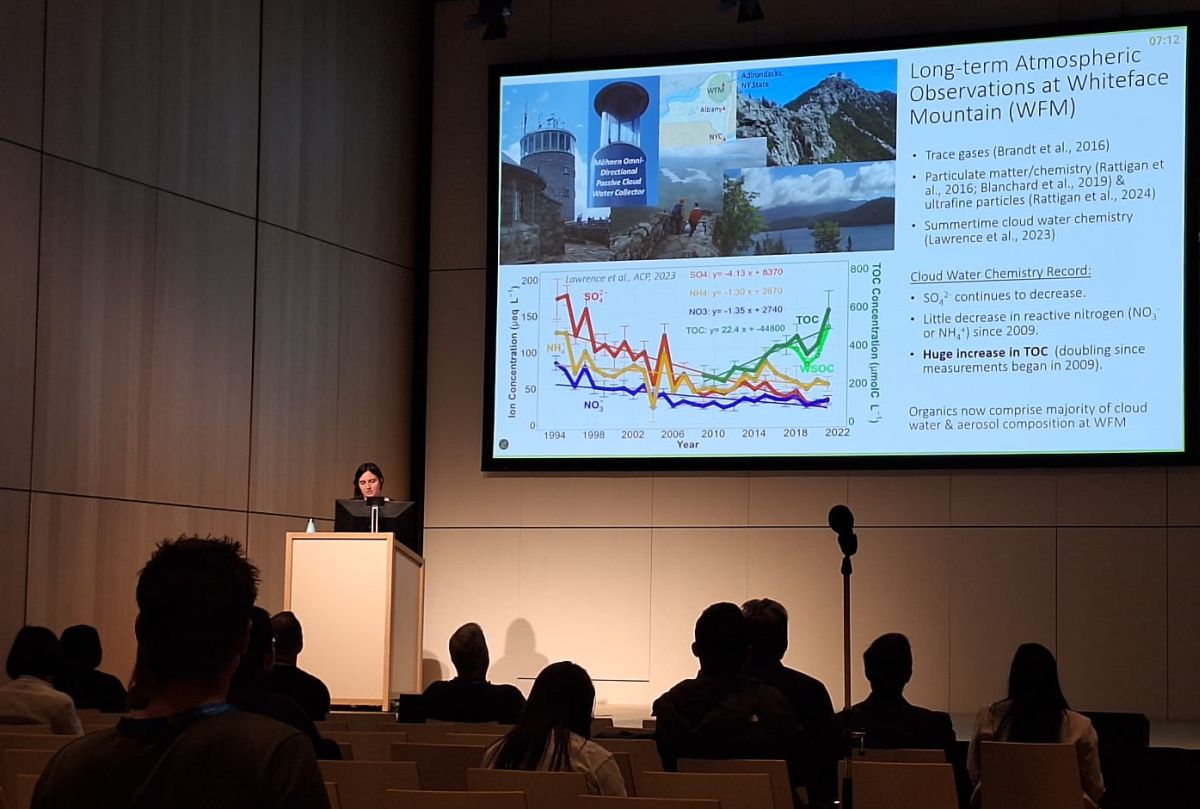
European Geophysical Union (EGU) Conference 2025May 2, 2025Archana, Sara Lombardo and I attended the EGU meeting in Vienna this year, presenting on 1) Regional trends in organic carbon within cloud water and precipitation samples in the NEUS, 2) Organic acids and the growing importance of ammonium at Whiteface Mountain (WFM), 3) a preliminary assessment of microbes filtered out of cloud water at WFM, and 4) Measurements of aerosol and cloud microphysics for an important subset of flights during the 2022 CHACHA field campaign in the Arctic. I learned so much from these two sessions, in particular: 1) Atmosphere-Ice-Ocean Interactions from Aerosols, Clouds, Biogeochemistry, and Climate Feedbacks in Polar Regions, and 2) Characterization, processes, and surface interactions of the atmospheric microbiome. Of course I also learned a lot at the session on Atmospheric organics: Sources, chemistry, and fate. It was great to spend more time with my mentor Barbara Ervens at the conference and to meet up with my former graduate advisor, Thanos Nenes, who I probably haven't seen since the Cloud Chemistry Workshop at Whiteface Mountain in 2016! |
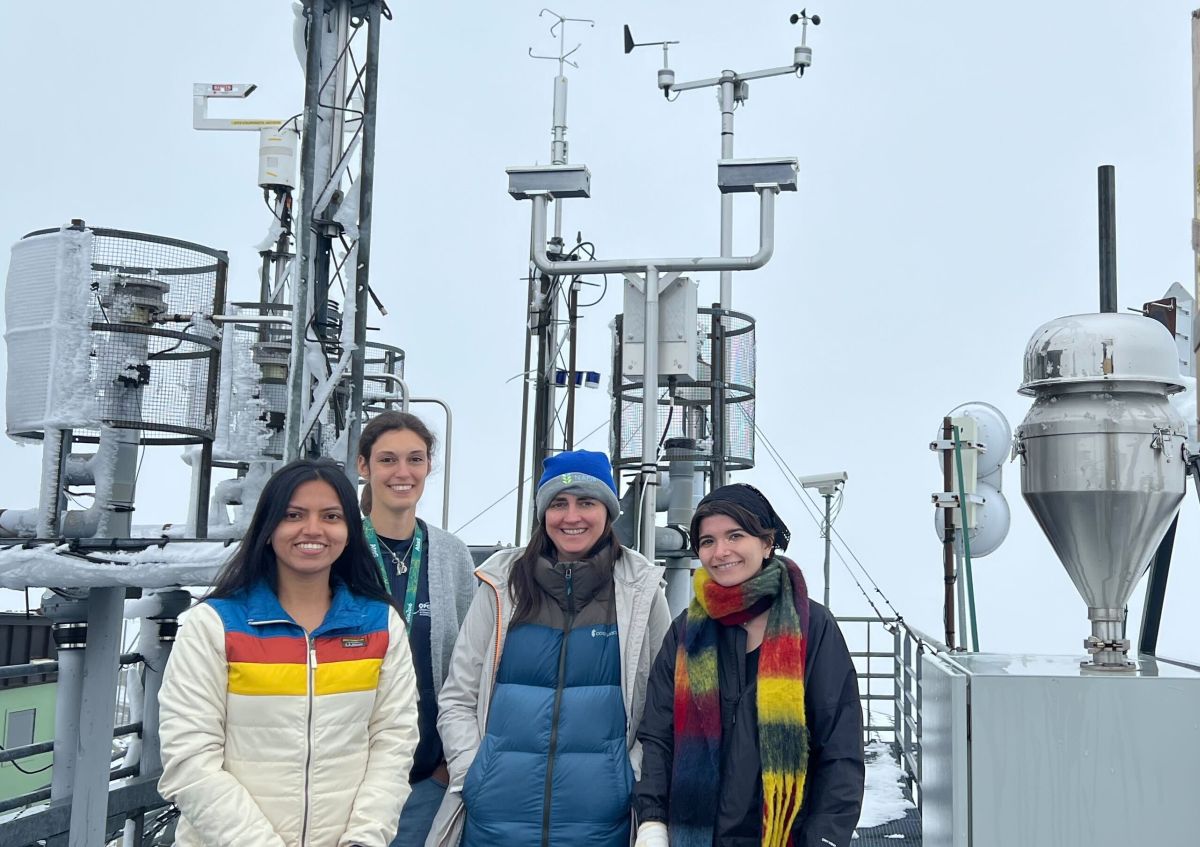
Puy de Dome, FranceApr 18, 2025Sara Lombardo, Archana and I visited Puy de Dome research station, an atmospheric monitoring site in central France with an exceptionally long history, where chemical, biological and physical properties of gases, aerosols, clouds and precipitation are measured. Angelica Bianco graciously gave us a tour of the beautiful and well-equipped facility. We also met with Pierre Amato, Barbara Ervens, Laurent Deguillaume and others at Clermont Ferrand. We are so grateful to have had the opportunity to see the site firsthand and learn from these experts, especially in relation to their cloud microbiological research! |
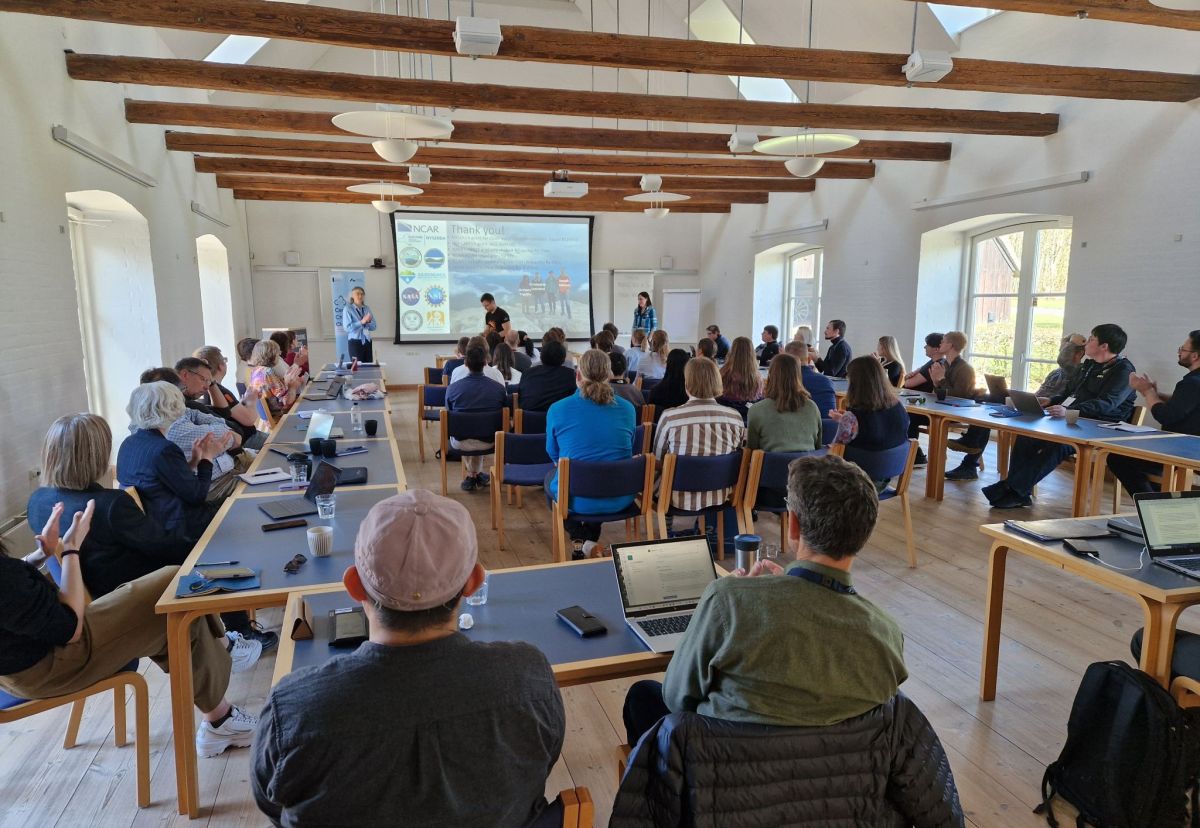
Chemistry of Clouds Conference 2025Apr 9, 2025Archana, Sara Lombardo and I were grateful to be able to attend the first ever Chemistry of Clouds Conference in Denmark this year, in part through support from the Danish National Research Foundation. What a great opportunity to meet and learn from European experts in such a focused setting, with presentations covering laboratory studies of fundamental microphysical processes and interfacial chemical reactions to long-term cloud and aerosol measurements at locations spanning the globe. |
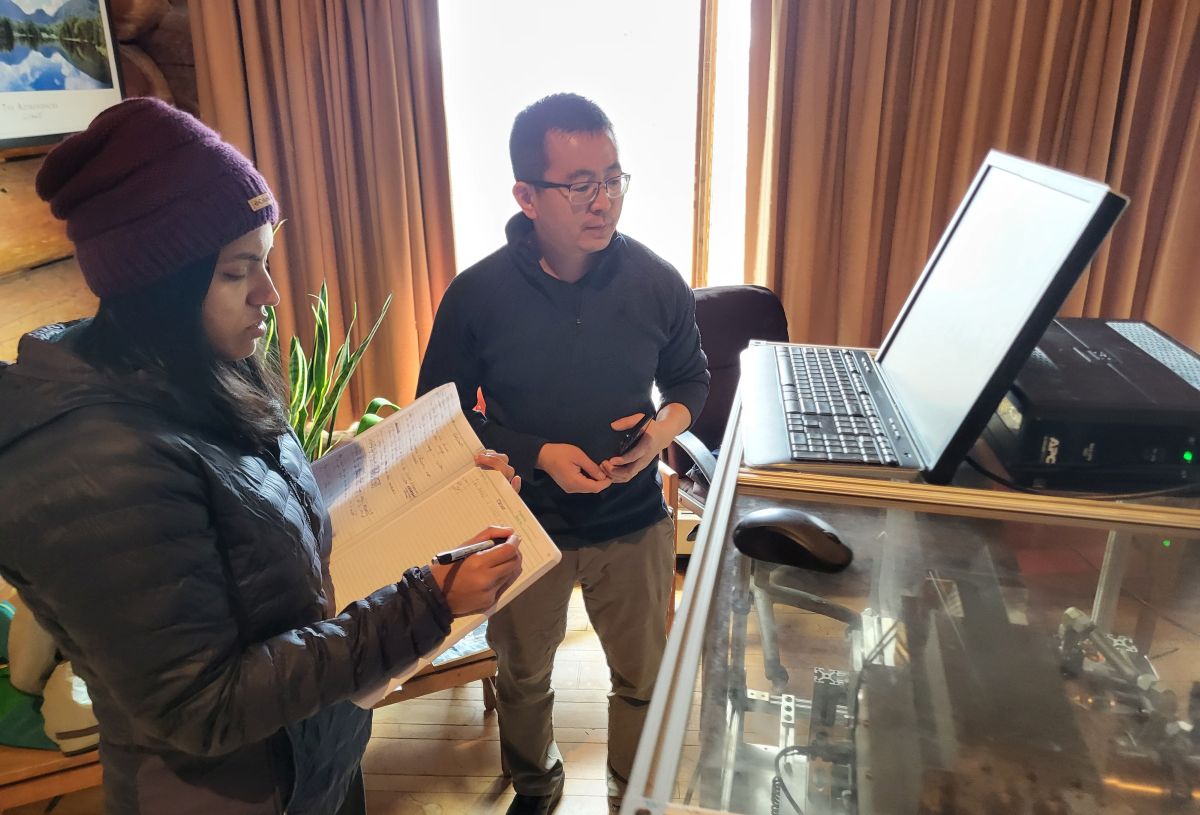
Sampling nanoparticles at the WFM LodgeMar 24, 2025Jie Zhang brought our High Resolution Time of Flight Aerosol Mass Spectrometer (HR-ToF-AMS) to Whiteface Mountain (WFM) via the ASRC Sprinter Van for a quick round of indoor tests focused on particulate emissions from aging/disintegrating foam cushions. We could see in real time that there was a strong organic nanoparticle signal associated with several of the cushions that we shook and/or struck to produce a dust cloud under the low relative humidity conditions within the WFM Lodge. Unfortunately Adam couldn't be with us as planned due to illness, but luckily Archana was able to fill in and take notes. Adam is working to analyze the data, and evaluate the possibility that nanoplastic and/or PFAS-containing particles were sampled, with potential human health implications (we wore masks). |

Adirondack (ADK) Park Lobby Day 2025Feb 23, 2025The ADK Lobby event at the NYS capitol in Albany this year was again organized by the Adirondack Council, which pushed for a list of specific legislative priorities for 2025-2026 focused on protecting the Adirondack Park, including clean water/air, green jobs and climate resilient wilderness lands. This lobby event came on the heels of the event organized by the Nature Conservancy two weeks prior advocating for continued Environmental Protection Fund support from NY State. As in 2024, a group of approx. 35 high school students from the Timbuctoo Climate Science and Careers Institute bused down from NYC to participate in the ADK Lobby Event, and took the opportunity to visit ETEC the day before, where I gave them a tour and an overview of UAlbany and the research being done at ASRC. |
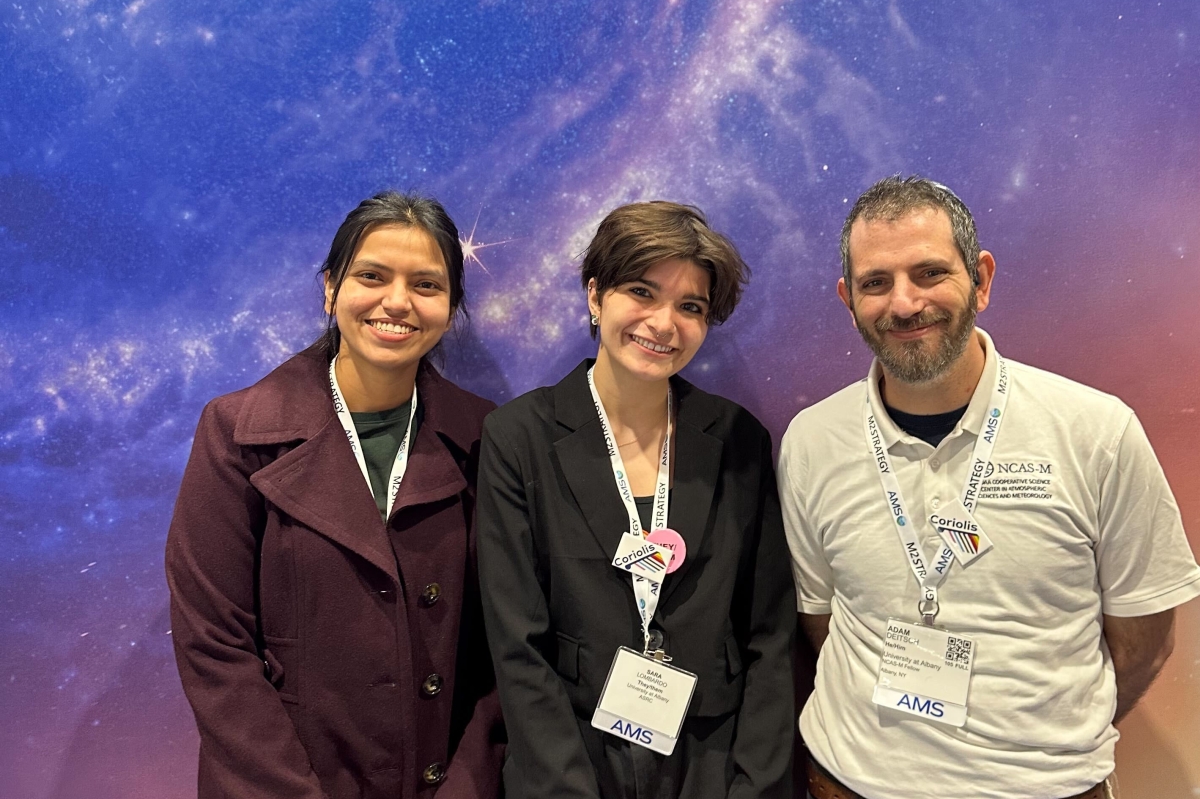
American Meteorological Society Conference 2025Jan 14, 2025Archana, Sara and Adam attended the AMS meeting in New Orleans this year and gave presentations on four topics ranging from: 1) cloud water and aerosol chemical composition at Whiteface Mountain (WFM), 2) preliminary assessment of microbes filtered out of cloud water at WFM, 3) aerosol and cloud microphysics for an important subset of flights during the 2022 CHACHA field campaign in the Arctic, and 4) use of a high resolution aerosol mass spectrometer to measure nanoplastic PFAS particles. |
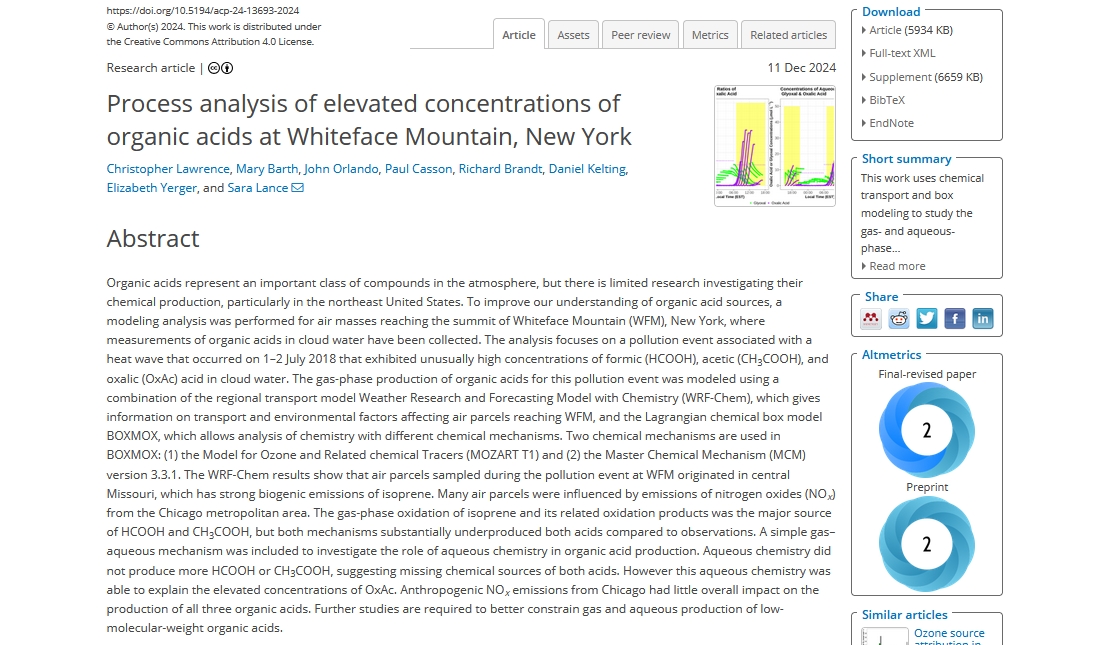
Chris and Mary publish at ACP!Dec 11, 2024Atmospheric Chemistry and Physics published the paper Chris wrote before departing my group at UAlbany, which was written in close collaboration with Mary Barth, modeling organic chemical transformations during long-range transport to Whiteface Mountain with a focus on organic acid concentrations. The paper highlights the importance of both biogenic (natural) and anthropogenic (human) emissions to air quality, for a specific heat wave and air pollution event in early July 2018, while also showing that many unanswered questions remain about the evolution of organic molecules over multiple days transit within the atmosphere. |
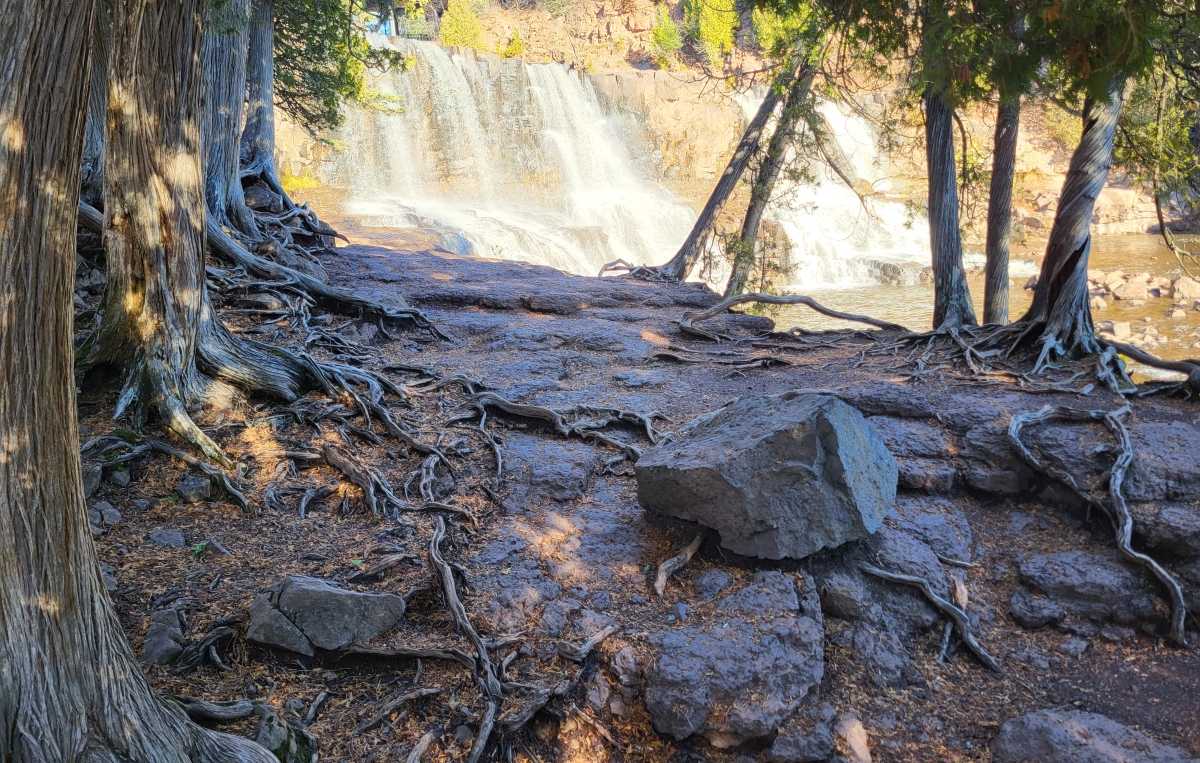
National Atmospheric Deposition Program MeetingNov 8, 2024I was lucky to be able to attend the NADP meeting in Duluth MN this year and present a poster describing results from the project Chris has been working on in his final months at UAlbany, investigating whether there is a broader regional signal for the increasing organic carbon trend we have observed at Whiteface Mountain and possible reasons for this trend. A paper on this is being prepared for submission to the journal Biogeosciences. NADP always plans the best field trips with a visit to different wet deposition sites from within their extensive observational network, and this year we visited Wolf Ridge, with a stop at Gooseberry Falls along the way. |
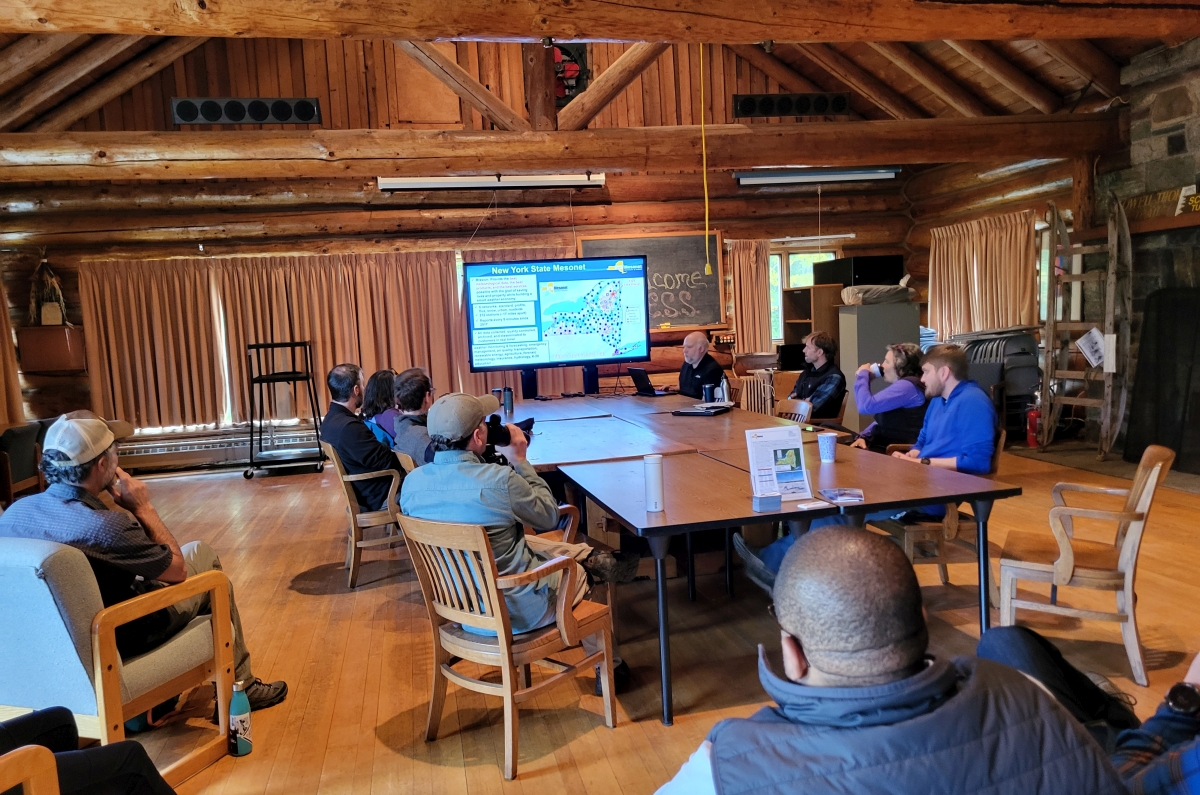
Week at WhitefaceOct 2, 2024Our collaborators at UNH, UVM and elswhere came to visit Whiteface Mountain on Wednesday capping their scheduled site visits, as part of the NorthEast Snow Survey (NESS) feasibility study.Then on Friday, Paul and I met up with visitors from UAlbany, NYSDEC and ORDA to connect about our mutual interests (relating to the elevator and other shared infrastructure/facilities on the mountain). Tues and Thurs were allocated to cleaning out the summer-focused instrumentation and preparing for winter. Luckily the weather remained clear most of the week, providing us and our visitors with a beautiful view of the mountains and trees. |
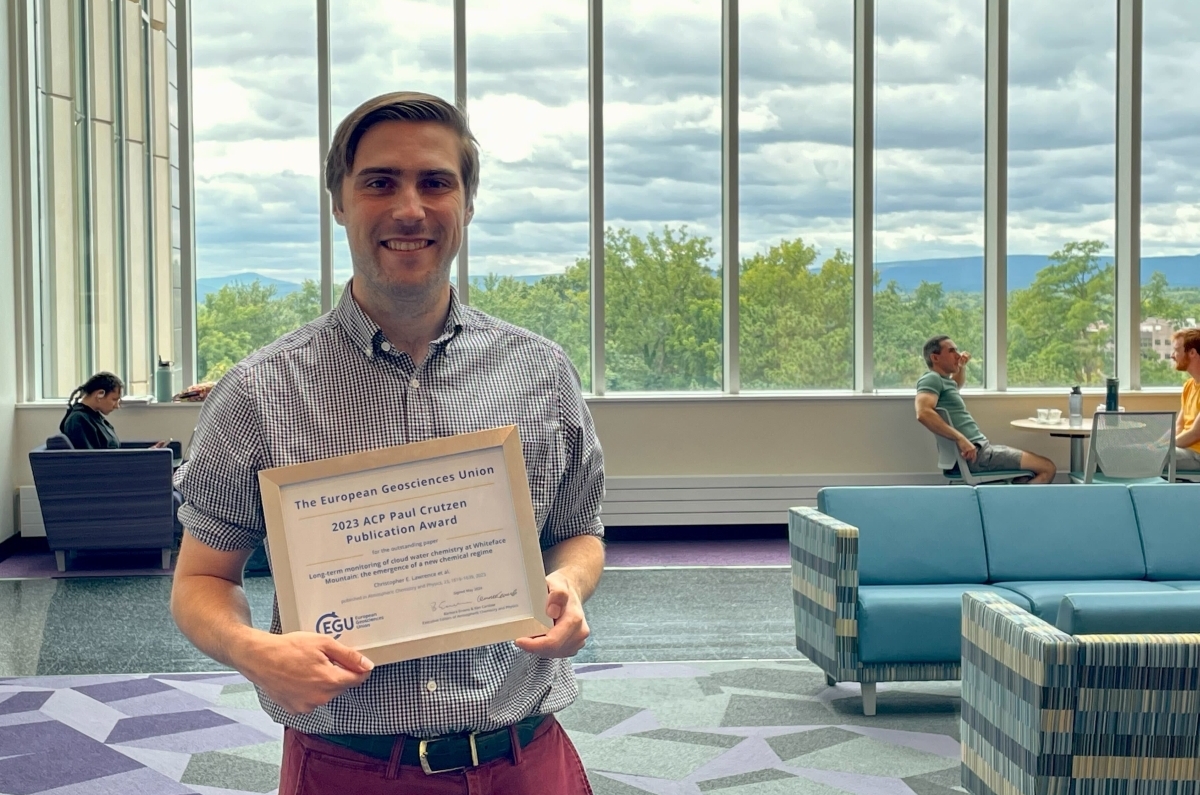
Chris Lawrence Doctoral Defense!Aug 20, 2024I'm so pleased to announce that Chris Lawrence has successfully defended his PhD dissertation (the first student from my research group to do so), with Jim Schwab, Fangqun Yu, Justin Minder, Mary Barth and I sitting on his PhD committee. These are the remarks I gave about Chris prior to his PhD defense, highlighting some of the honors he has received and work he has done while working with me, and his next steps.While she was in town, I also took the opportunity to take Dr. Barth back up to visit Whiteface Mountain, where she gave a Falconer Lecture on "The Role Clouds Play in Affecting the Atmospheric Composition". |
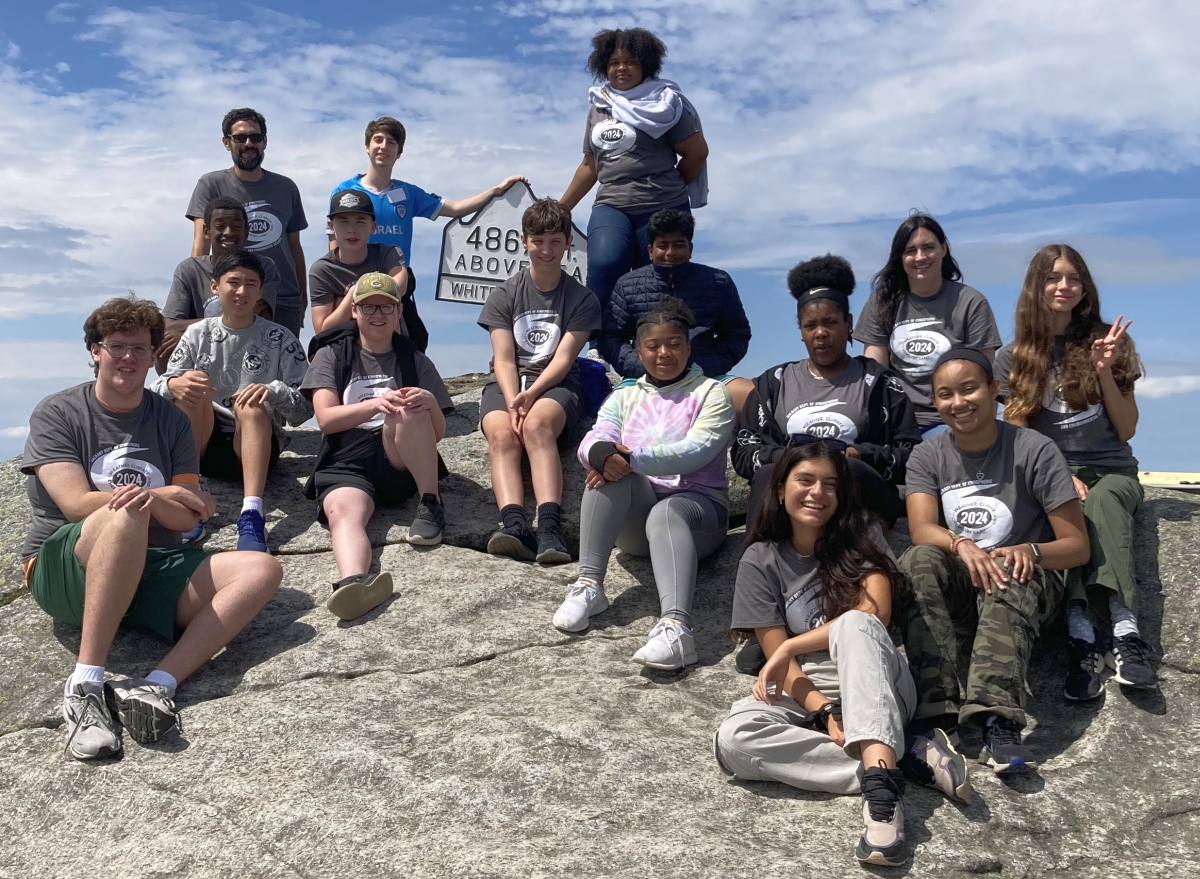
UAlbany Weather, Climate & Chemistry Camp 2024Aug 9, 2024Justin Minder and I held the summer camp July 31 - Aug 9 this year, and 14 high school students joined us from a wide range of school districts across NY state (with one student traveling all the way from Spain!). As in past years, students were exposed to a wide range of subjects relating to weather, climate and chemistry, and we owe a debt of gratitude to all the grad students, faculty and staff who volunteered their time to give these students a peek into their worlds. The heat wave and heavy smoke haze encountered during the first few days of camp from wildfires burning in the NW US, and the heavy precip encountered on the last day of camp with the passing of tropical storm Debbie, allowed us to showcase some of the air quality and weather phenomena highlighted in our camp curricula. Luckily, these extremes were tempered on the second to last day of camp with cool temperatures and clear visibility during our field trip to Whiteface Mountain - a lovely day for a hike! |
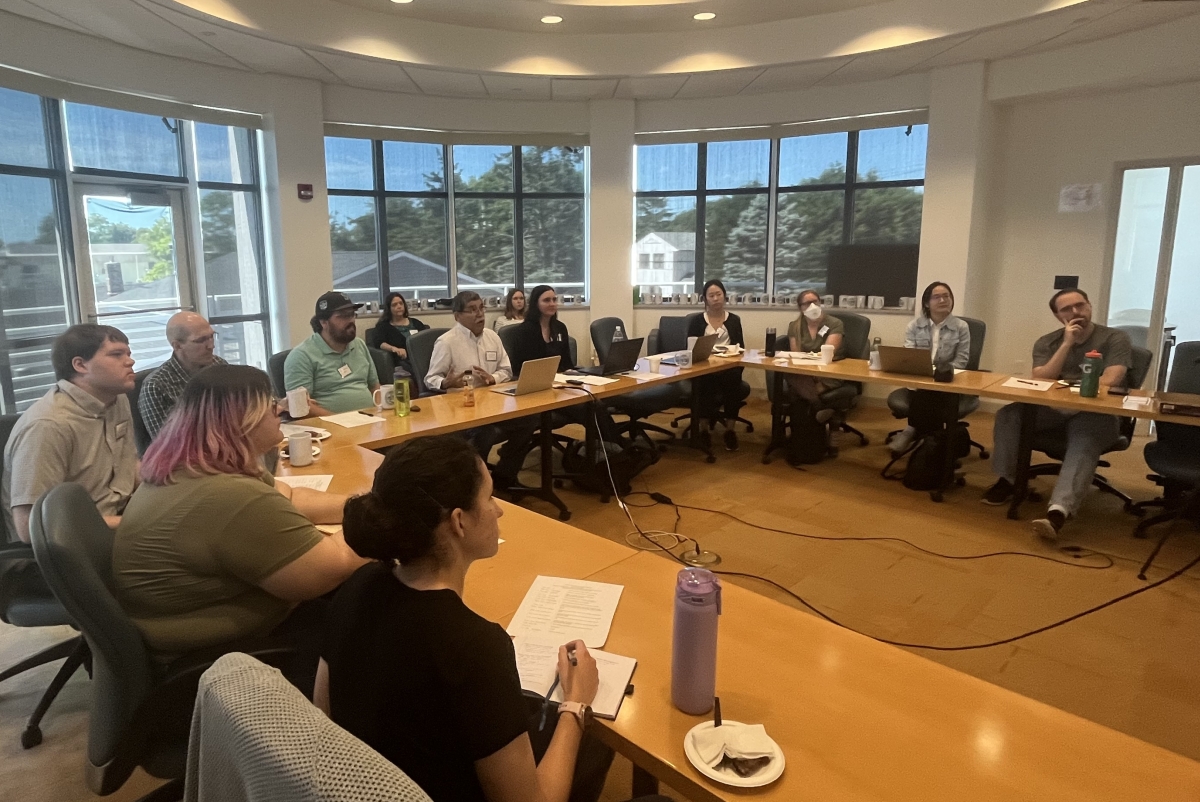
CHACHA WorkshopJune 28, 2024This week, the CHACHA team reconvened at StonyBrook University to discuss progress and plans for analyzing and reporting on the CHACHA dataset, in addition to introducing a large contingent of new team members. Fourteen papers were identified, with another 7 to follow in the coming years (after completing offline chemical analyses and conducting modeling studies). It was also an opportunity to visit the StonyBrook Marine Station in the School of Marine and Atmospheric Sciences at SBU, a first for many of us.Dr. Paul Shepson, Dean of SoMAS, is missing from the photo because he was holding the camera. |
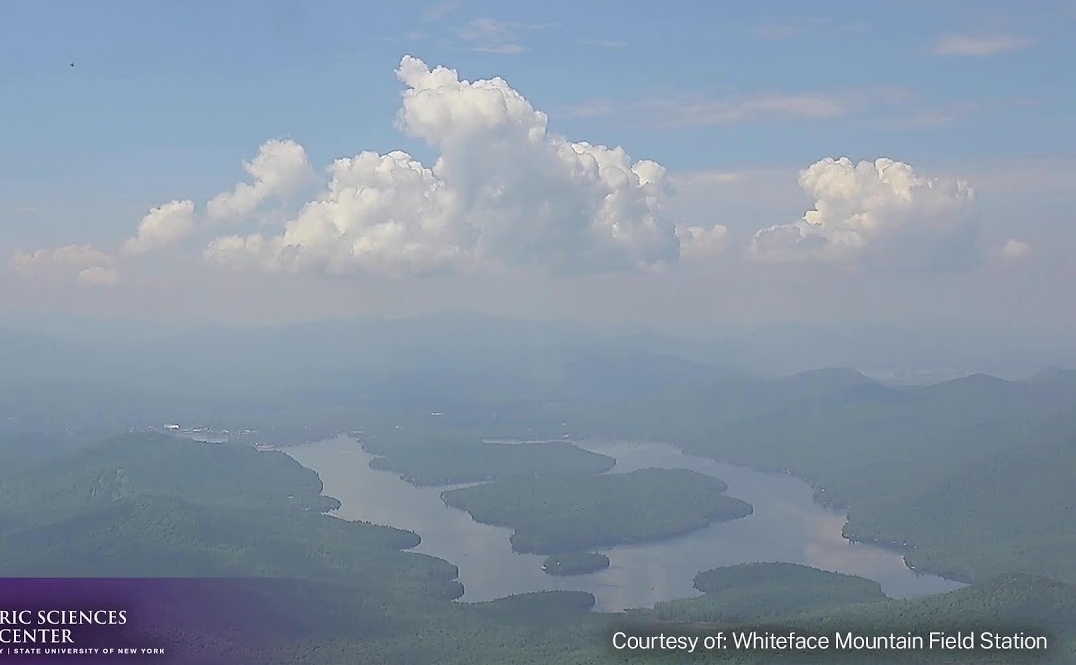
Hazy days of summerJune 19, 2024This week, Archana, Sara and I finally deployed the PILS to the WFM summit, just in time to catch the multi-day heat wave and haze event of June 2024. This summer, we made some changes to our sample line to reduce our TOC baseline, after consulting with Amy Sullivan and Jeff Collett. We also learned a lot during weeks of lab tests in Albany this spring with the PILS and HR-AMS sampling known calibration aerosols (ammonium and sodium oxalate) side-by-side. Boy, was it hot and tiring working up there this week, but we're excited to characterize this event! The haze reduced visibility to less than half of normal (in humid, but not cloudy, conditions). |
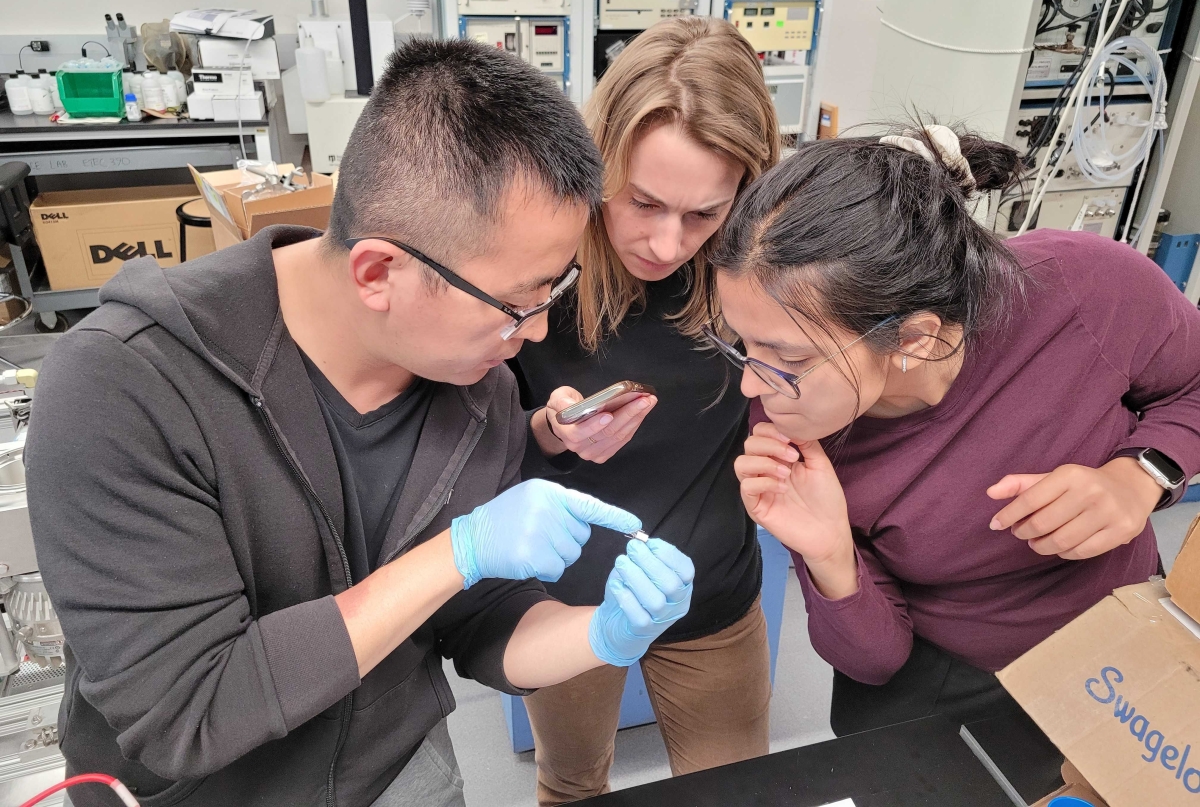
Dr. Jie Zhang is now a faculty member at ASRCMay 8, 2024The last time we replaced the filaments in the High Resolution Aerosol Mass Spectrometer (HR-AMS) in 2017, Jie was a graduate student. Now we are sharing a lab and he is helping to teach my students about atmospheric chemistry measurements. It's so great to have Jie still here working with us and contributing more than ever now as a fellow faculty member. |
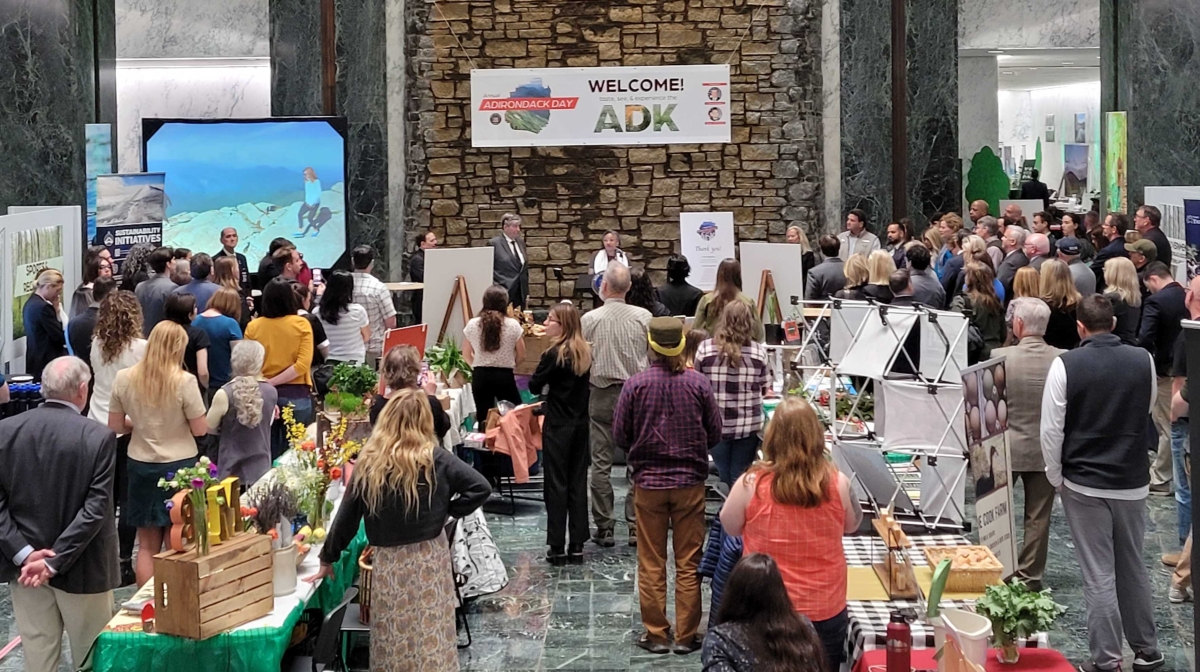
ADK Lobby Day at the NYS CapitolMay 6, 2024To thank legislators for a $100k line item within the Environmental Protection Fund to support cloud water chemistry and air quality monitoring at Whiteface Mountain in the NYS budget this year, my group (Archana, Sara, Adam and I) participated in a lobby event at the capitol, which involved many different stakeholders from the Adirondacks. Special thanks to Scott McKim and the ADK Mountain Club for helping us to secure this funding alongside the Cary Institute and ADK Watershed Institute. |
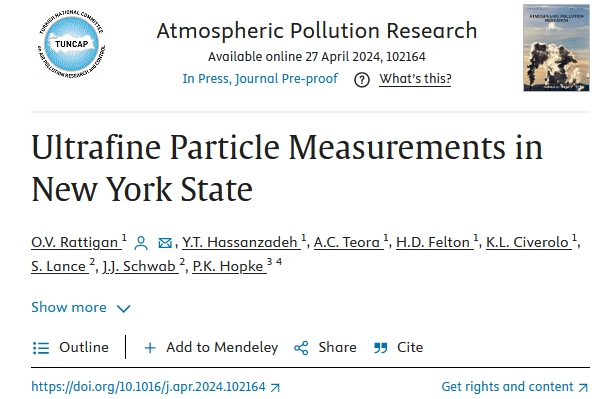
Our DEC collaborators publish a paper on ultrafine particlesMay 1, 2024This recently published paper evaluates ultrafine particles (UFP, in this case referring to particles with diameter of 7 nanometers to 1 micrometer) at several urban and remote sites across NY State, including at the summit of Whiteface Mountain. UFP generally dominate particle number concentration and pose a hazard to human health as their small size allows them to be deposited deep into the lungs, but current federal regulations focus instead on the particle mass concentration, which tends to be dominated by particles larger than 400 nanometers, which are less numerous. |
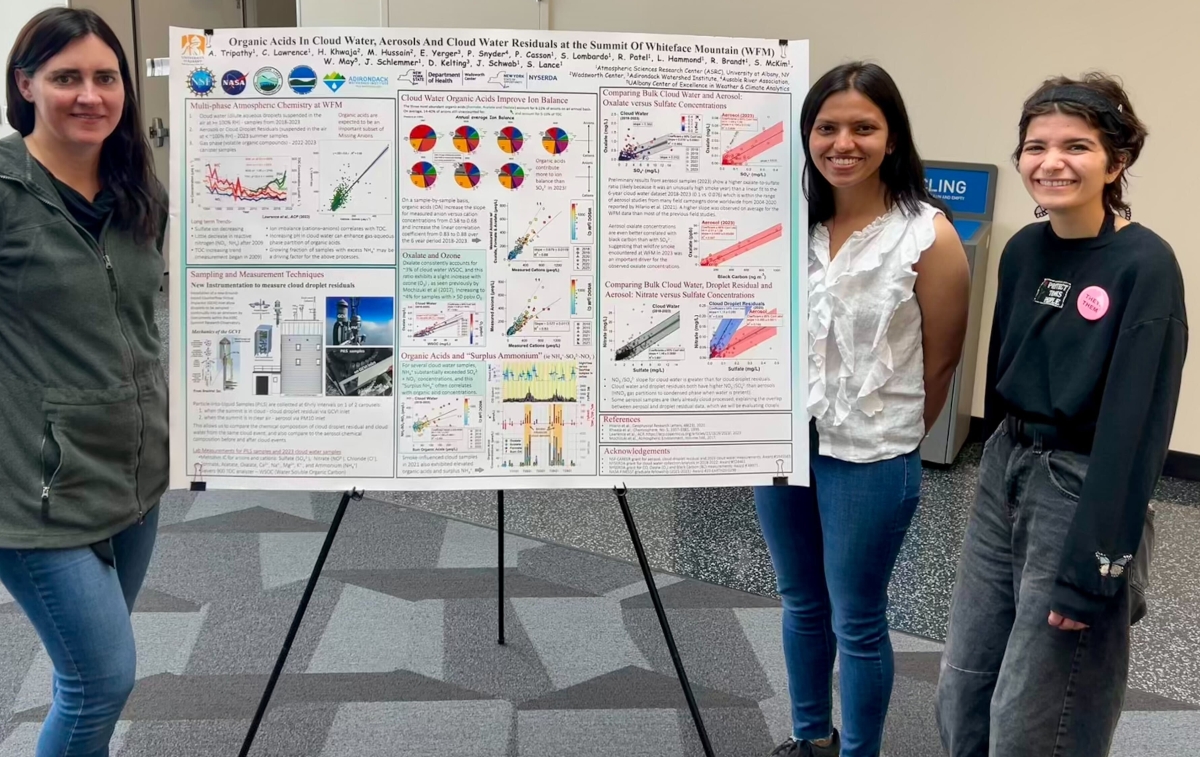
Archana presents a poster for UAlbany ShowCase DayApr 30, 2024Archana's poster titled "Organic Acids In Cloud Water, Aerosols And Cloud Water Residuals at the Summit Of Whiteface Mountain (WFM)" was presented for UAlbany Showcase Day and details the cloud water chemistry measurements we've been conducting since 2018 and the aerosol and cloud droplet residual chemistry measurements we began undertaking in 2022 and 2023. Altogether, the goal of these measurements is to help us understand how aerosols are impacted by cloud processing (and, conversely, how the cloud water chemistry monitoring reflects aerosol and gas phase chemistry). |
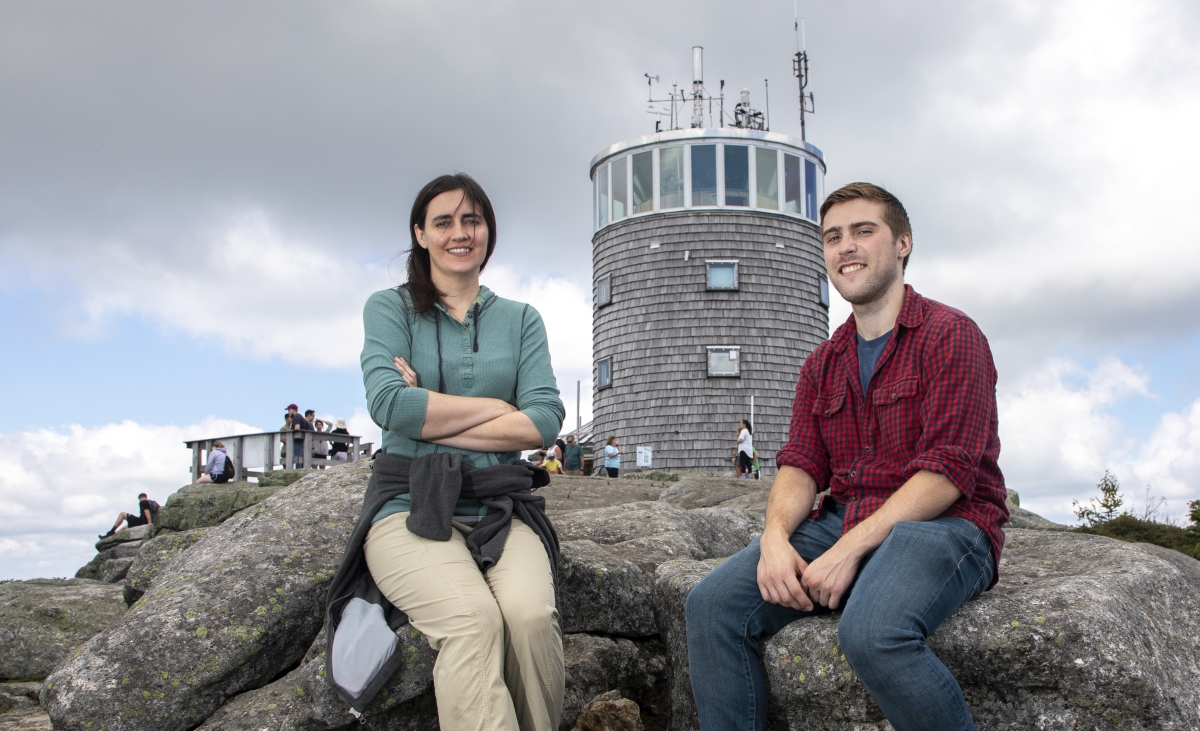
Paul Crutzen Publication Award!Mar 26, 2024Our paper published in Atmospheric Chemistry & Physics, titled “Long-term monitoring of cloud water chemistry at Whiteface Mountain: the emergence of a new chemical regime”, was selected as a winner of the 2023 ACP Paul Crutzen Publication Award! (one of two papers selected this year, from amongst more than 1000 submissions). We are so honored and grateful that this prestigious group of people have formally recognized the value of the long-term observations at Whiteface Mountain. |
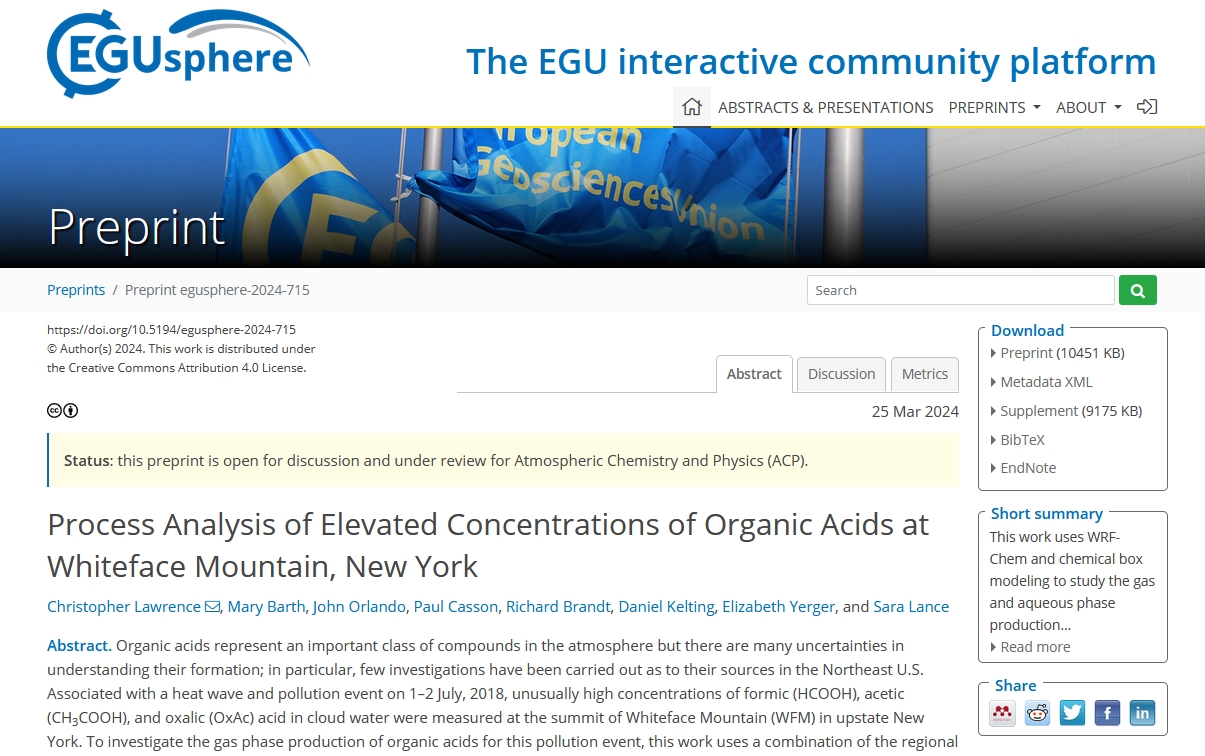
Chemical Box Model Paper Submitted for Peer Review!Mar 25, 2024This modeling study evaluates the chemical processes leading to organic acid formation during multi-day atmospheric transport to Whiteface Mountain for a polluted case study in 2018, in comparison to in-situ measurements of ozone and cloud water chemistry. Special thanks to Dr. Mary Barth for her guidance and work on this research and manuscript. |
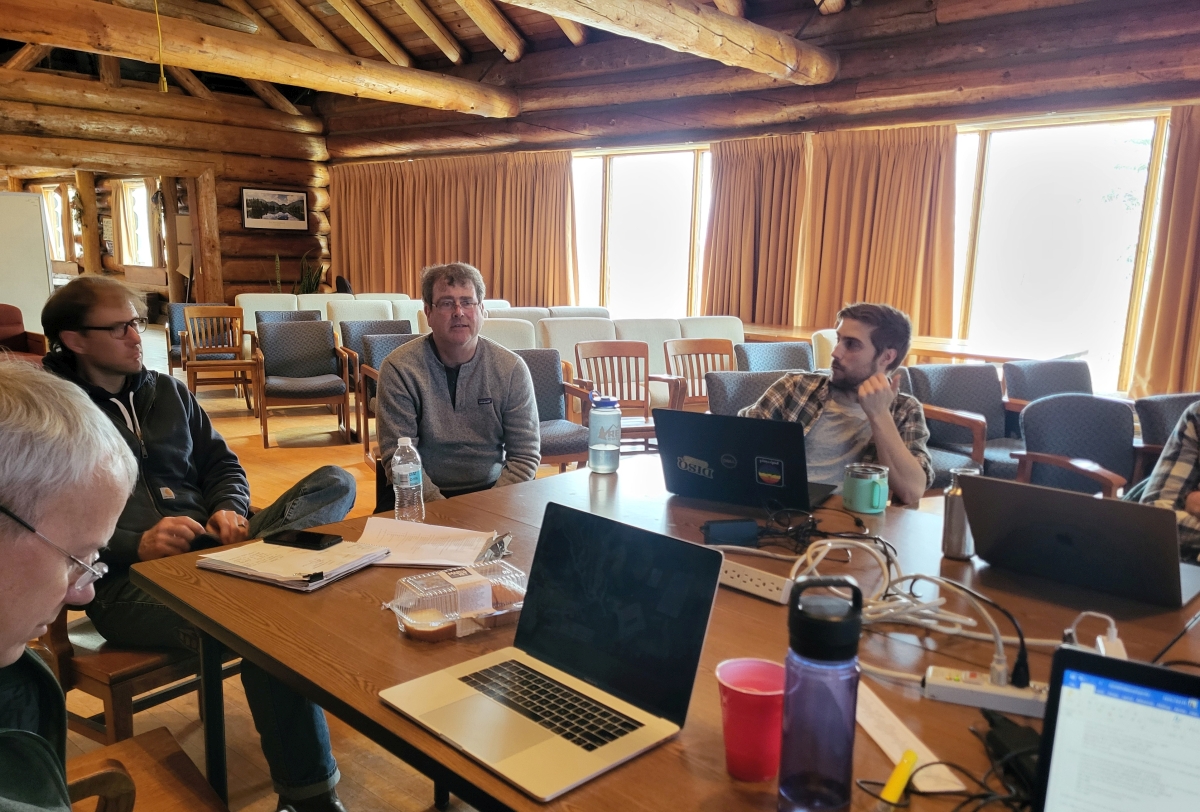
2024 Whiteface Mountain RetreatMar 15, 2024As the new director of Whiteface Mountain field station, I convened the first annual retreat at WFM to discuss current science and outreach initiatives at WFM (funded and unfunded), prospective funding opportunities, partnerships and infrastructure, with Scott, Mark, Paul, Jim Schlemmer, Chris Thorncroft and Chris Lawrence (who is planning/hoping to continue to use WFM data in his future postdoctoral research). What a great team, who have accomplished so much with so little for so long! |
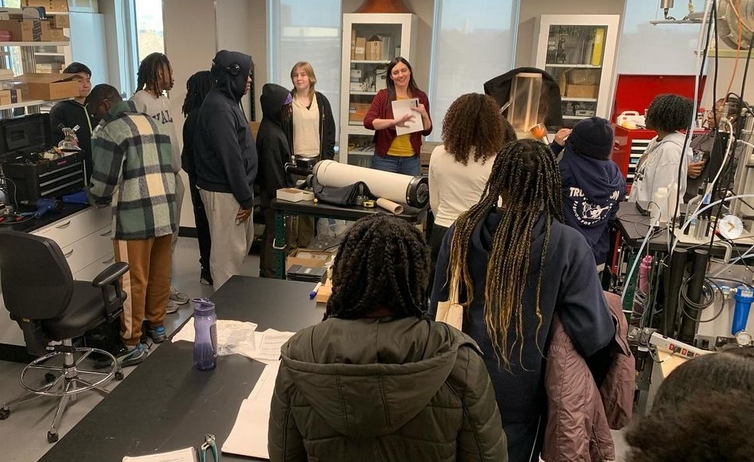
TimbuctooFeb 25, 2024I had the opportunity to spend a few hours with high school students who had participated in the Timbuctoo Climate Science and Careers Summer Institute and introduce them to atmospheric sciences research at ASRC and UAlbany this weekend. These students impressed me with their curiosity and drive, and I expect to see them accomplish great things in the future, tackling environmental science issues from a wide range of angles, from business to law to architecture to biochemistry. |
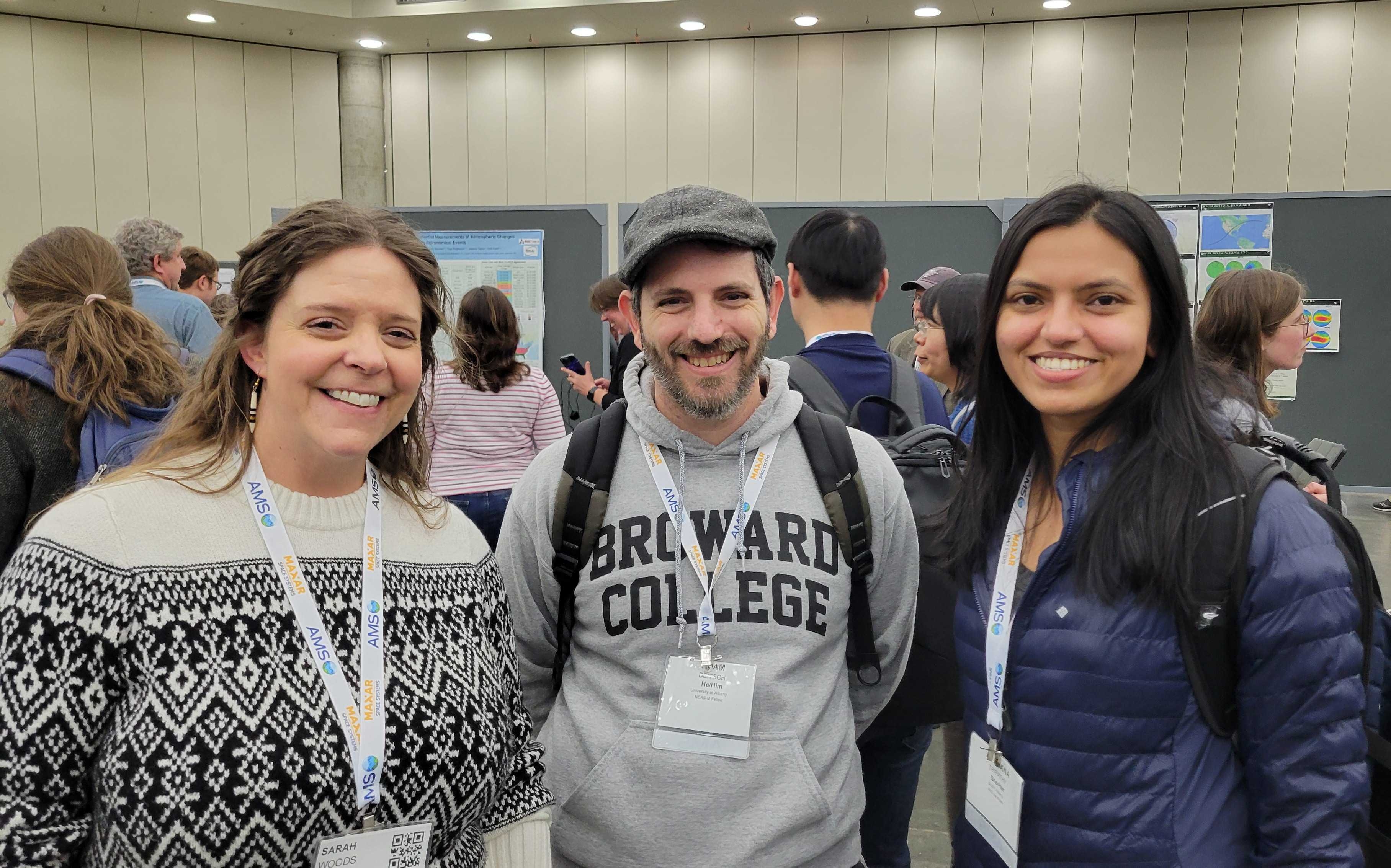
American Meteorological Society Conference 2024Jan 31, 2024Archana and Adam gave poster presentations at the AMS conference this year in Baltimore on aerosol and cloud water chemical composition measurements at Whiteface Mountain (WFM) with a focus on organic compounds, and on PFAS (i.e. "forever chemicals") in cloud water and precipitation samples from WFM, respectively. They were able to meet up with Sarah Woods and Chris Hennigan there, as well! |
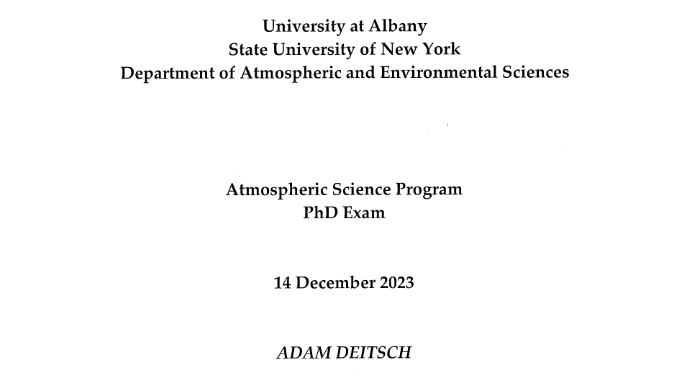
Adam passes his written qualifying examDec 14, 2023The two day exam comprised two questions posed by each of his committee members: Yanna Liang (ESE), Fangqun Yu, Chris Thorncroft and I. |
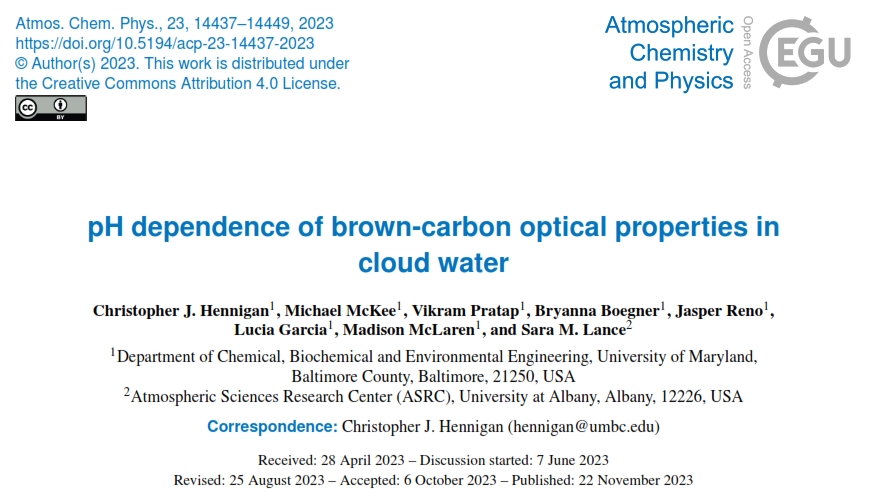
Paper published by our CollaboratorsNov 22, 2023Chris Hennigan published a paper in the journal "Atmospheric Chemistry and Physics" on the pH dependence of brown carbon absorption in cloud water collected at Whiteface Mountain. |
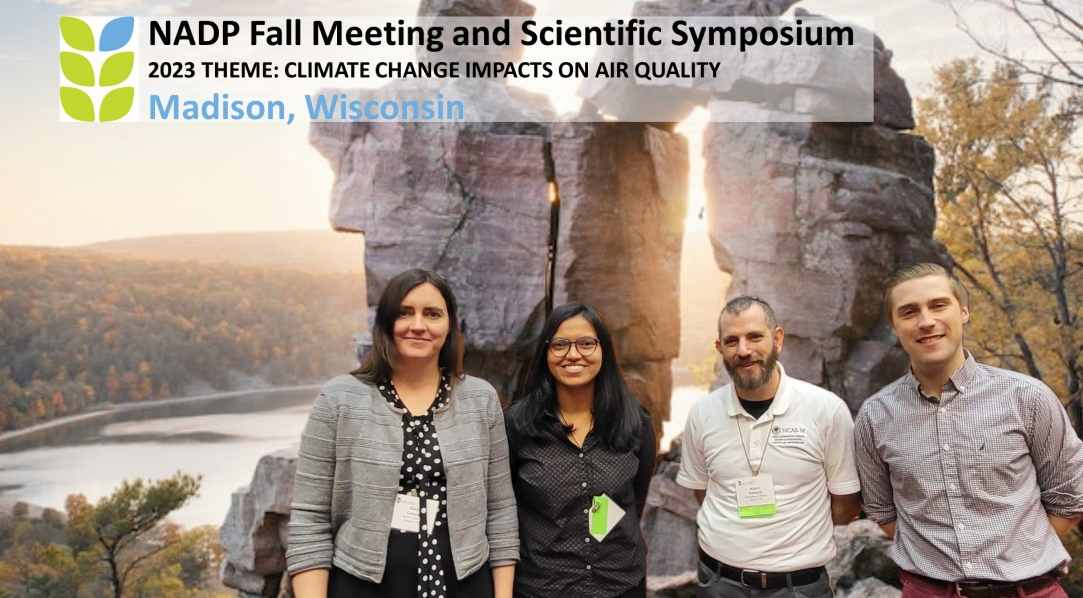
NADP MeetingOct 27, 2023Chris, Adam and Archana presented on cloud water chemistry at the National Atmospheric Deposition Program (NADP) Scientific Symposium that took place in Madison Wisconsin Oct 25-26 (with a field trip to the Devil's Lake State Park on Fri Oct 27). This was the first time both Archana and Adam have given oral presentations at a national conference, and they did great! We were also able to visit the Wisconsin State Laboratory of Hygiene and get a tour of the lab where our cloud water samples have been tested for Per-Fluoro Alkyl Substances (PFAS). |
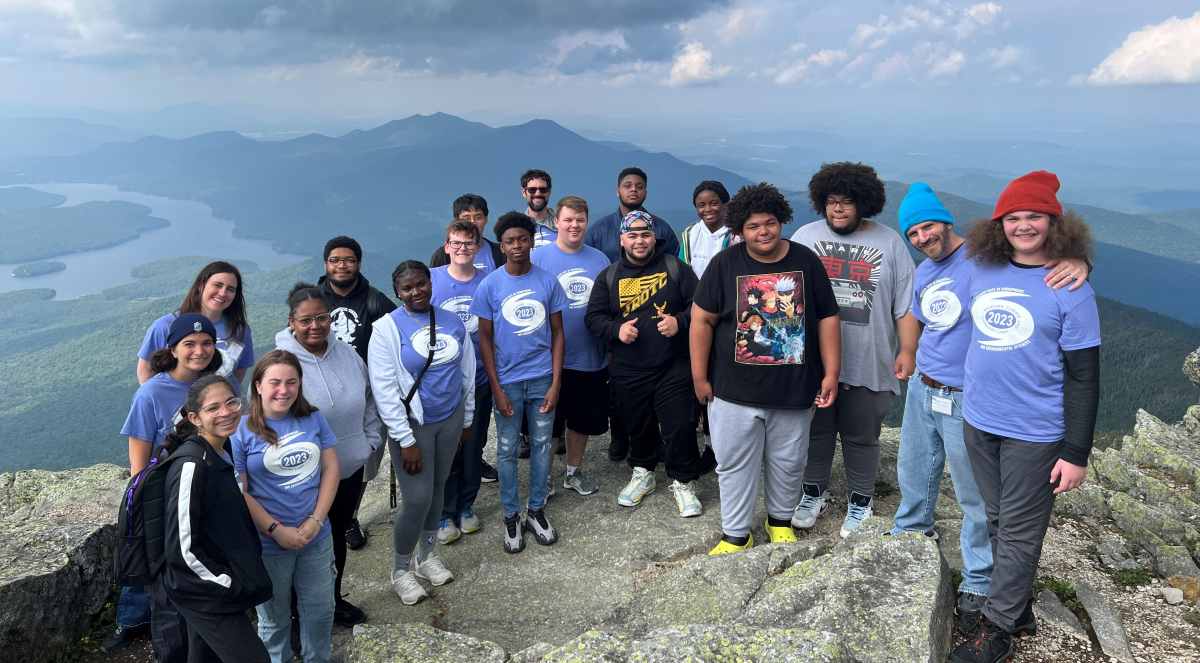
Summer Camp 2023Aug 11, 2023Justin Minder and I hosted the 2023 UAlbany Weather, Climate & Chemistry Camp for local area high school students at the SUNY ETEC building August 2-11, 2023 with a day trip to Whiteface Mountain on August 10. We had a strong contigent from the UAlbany STEP program join again this year and a few familiar faces from the 2022 and 2021 summer camps. Great group of kids this year! |
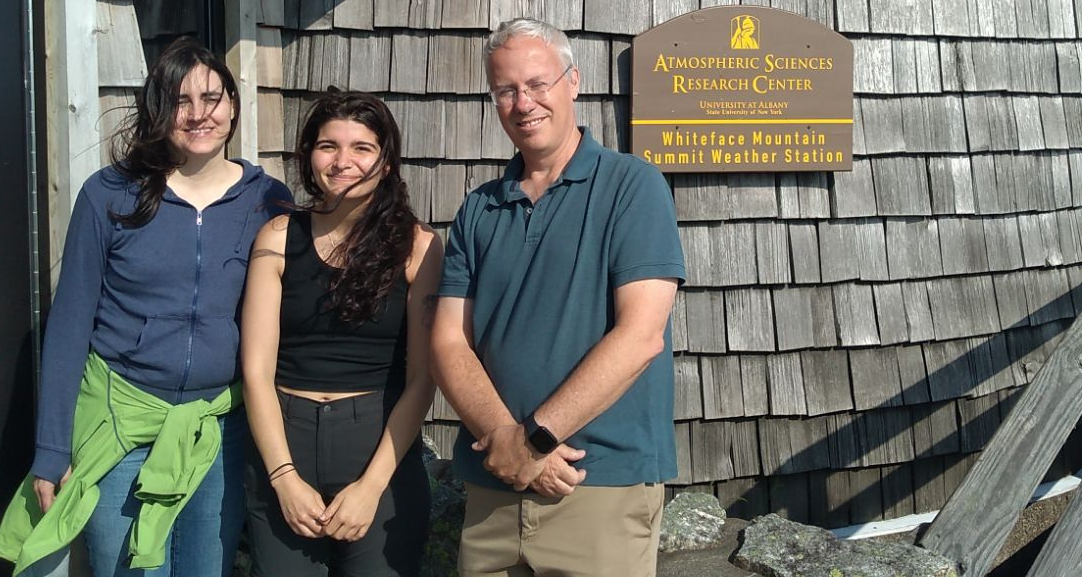
First week for Sara LombardoJul 11, 2023Sara joined Archana and I on a trip to Whiteface Mountain on Sara's first day, where we introduced them to the research being conducted on the mountain, in particular the Particle into Liquid Sampler (PILS) measurements of the aerosol and cloud droplet residual chemical composition. There was also a special Falconer lecture while we were up there that was jointly presented by Scott McKim & Mark Beauharnois with an overview about the research that has been conducted and is continuing on the mountain, as well as recent outreach efforts, followed by a walking tour of the WFM base site & measurements. Sara also got a chance to meet ASRC director Chris Thorncroft who came up to visit and attend the Falconer lecture. |
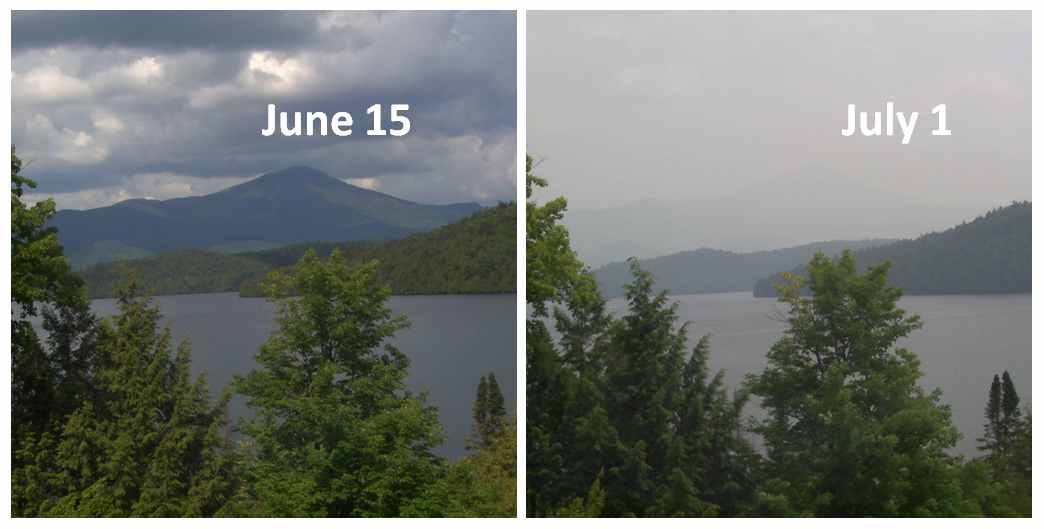
Smoky DaysJul 1, 2023This summer, Whiteface Mountain, the Adirondacks and the entire northeastern US have already experienced several extreme smoke events originating from wildfires in Canada, as illustrated by this set of photos, with mountain view from Lake Placid almost entirely obscured on July 1. The onset of these smoke events so early in the summer increases the likelihood that organic carbon in 2023 will be higher than ever recorded in our cloud water measurements, continuing the long-term increasing trend. |
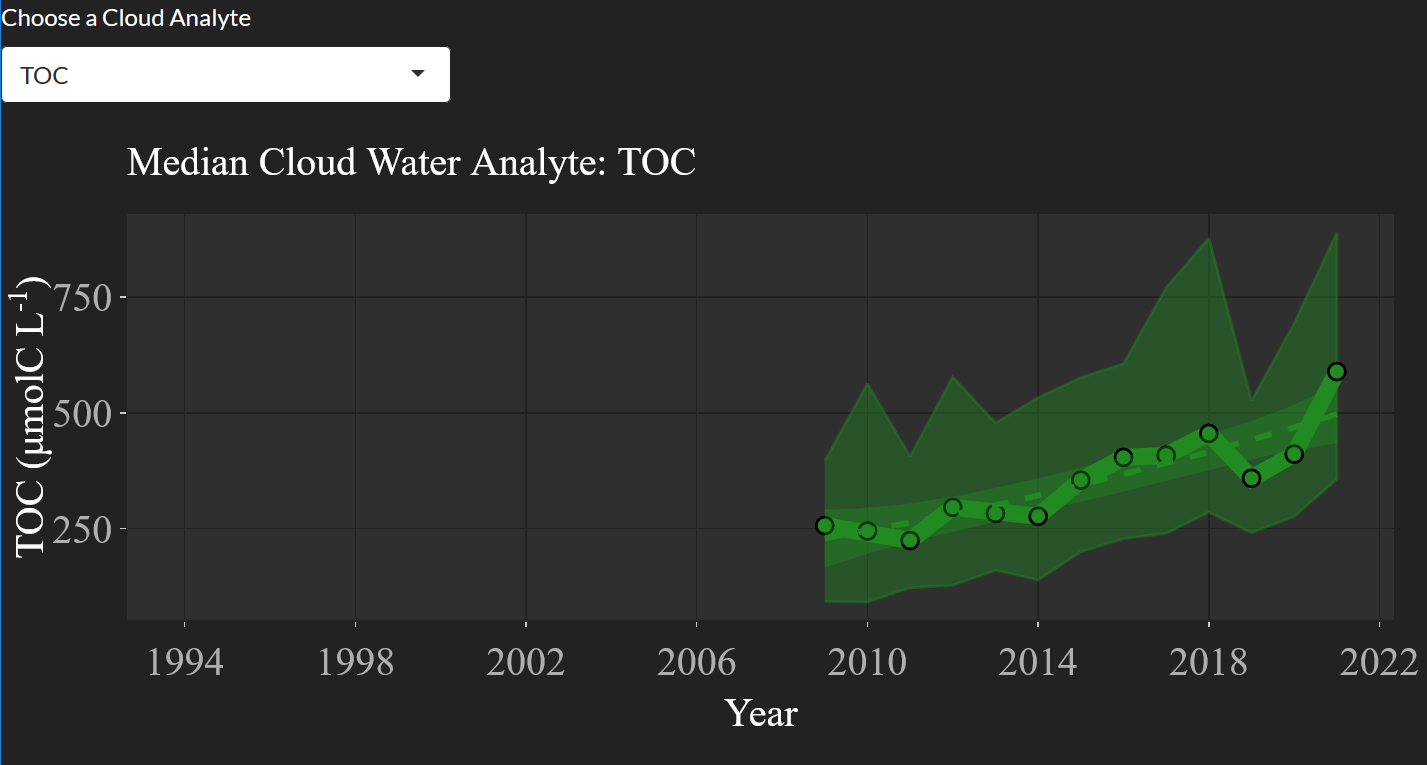
Interactive DisplayJun 20, 2023Chris created an interactive online tool to display the long-term cloud water chemistry data, showing both the median and range (25th and 75th quartiles) for each summer and a trendline based on a generalized additive model of all analytes (except for organic acids, which we only began measuring in 2018). |
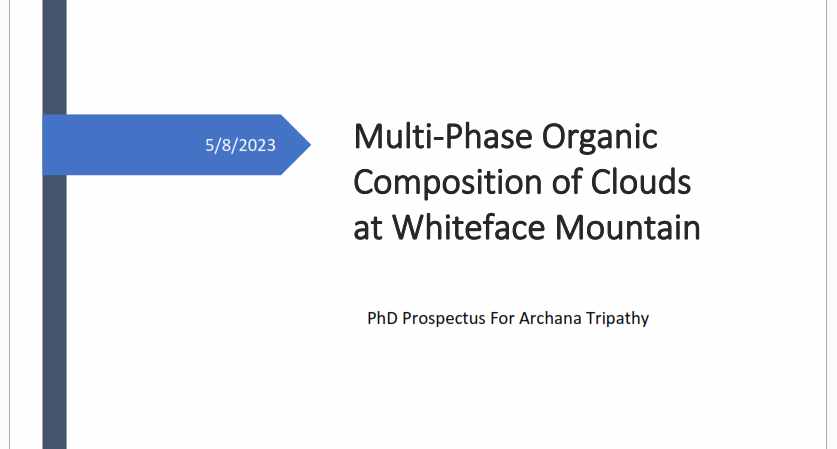
Archana passes her PhD prospectusMay 16, 2023Archana Tripathy passed her oral qualifying exam. The committee (comprised of Jim Schwab, Fangqun Yu, Aubrey Hillman and I) found no major deficiencies in her prospectus or research plan. This is the last major milestone in the PhD degree program until the dissertation and defense. |
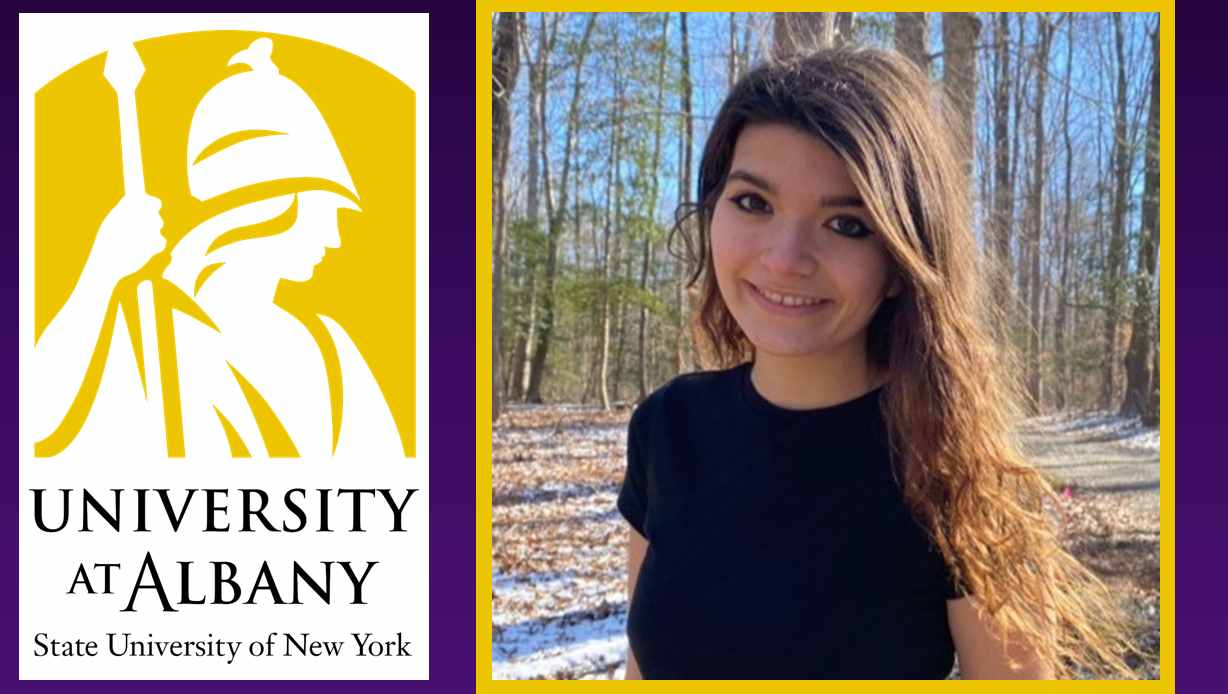
New graduate student to join the groupApr 13, 2023Sara Lombardo plans to join the group in the Fall and begin work at Whiteface Mountain this summer, and will be coming to UAlbany with undergraduate degrees in Chemistry and Environmental Sciences from University of Virginia. |
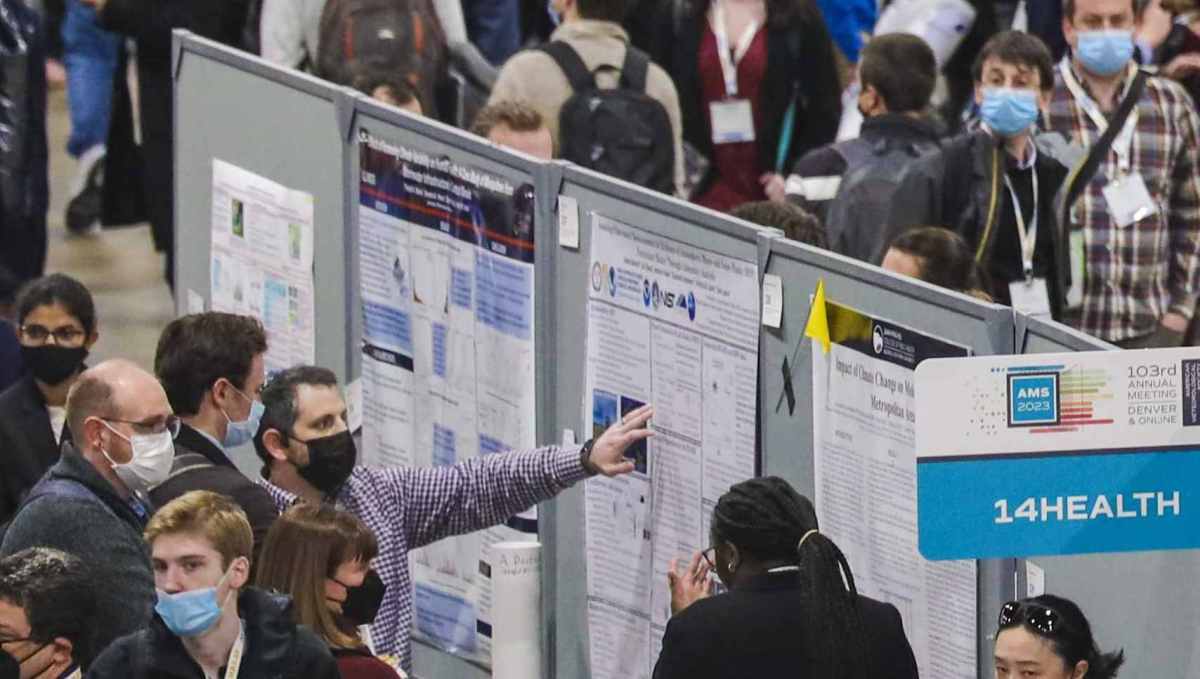
Adam wins a student poster awardFeb 18, 2023Adam's poster on characterization of micro and nanoplastic aerosol particles at the 14th Conference on Environment and Health, as part of the AMS annual meeting last month, wins best student paper award! |
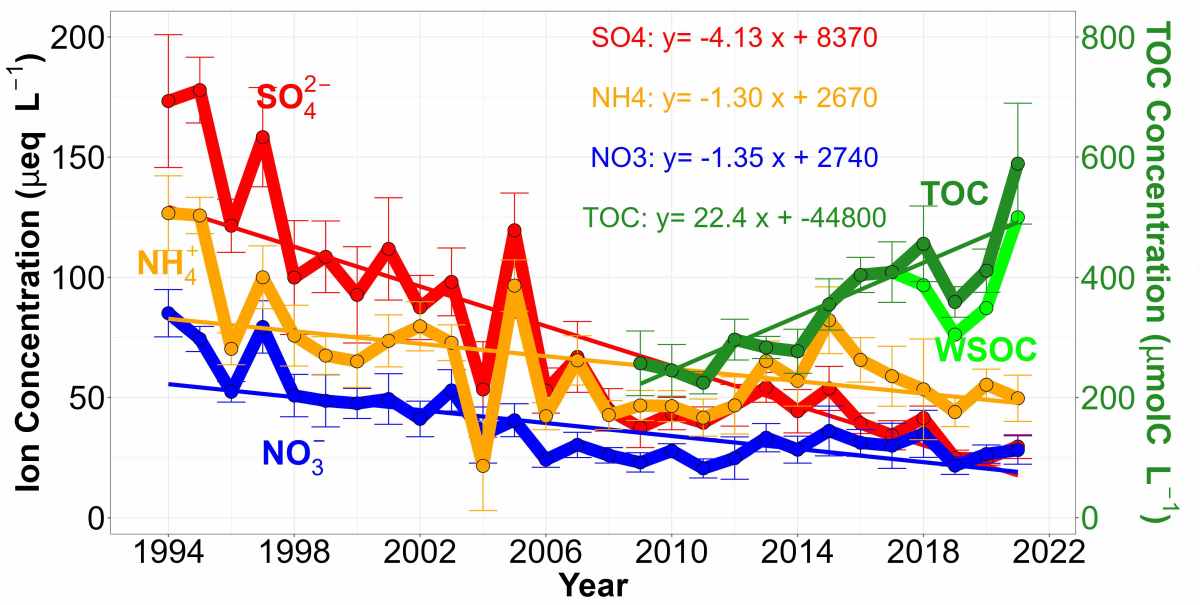
Chris publishes at ACP!Jan 27, 2023The paper on WFM cloud water long-term trends took awhile to publish, but we're happy with the resulting manuscript, which chronicles the emergence of a new chemical regime in cloud water characterized by increasing organic carbon concentrations and finds a clear association with wildfire smoke episodes. The next task is to quantify the impact from smoke versus other heterogeneous chemical processes that may be happening at the same time. |
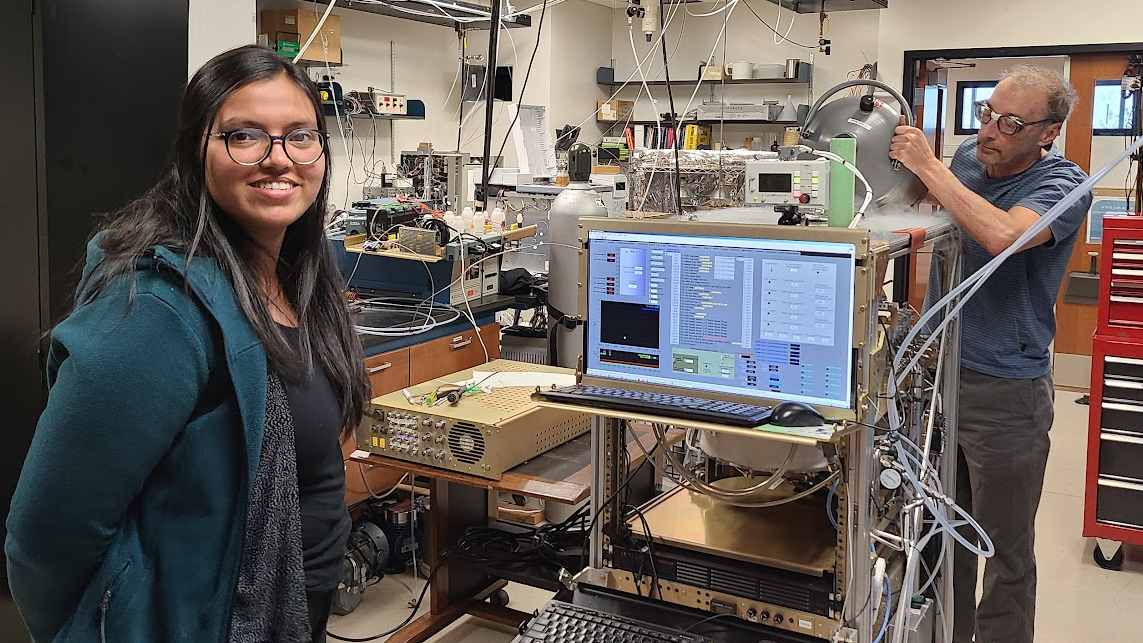
Archana begins a one month visit at NCARJan 20, 2023Archana is visiting Drs. Rebecca Hornbrook, Eric Apel and Mary Barth (and Alan Hills, pictured) at the NCAR Atmospheric Chemistry Observations and Modeling (ACOM) laboratory, having been awarded a Ralph Cicerone graduate fellowship. Goals for her visit are to learn more about gas chromatography and apply this knowledge to evaluate Whole Air Canister samples that she collected at Whiteface Mountain this past summer. The grant also provided the opportunity for me to visit NCAR for a week and give a seminar on our work. What a great opportunity! |
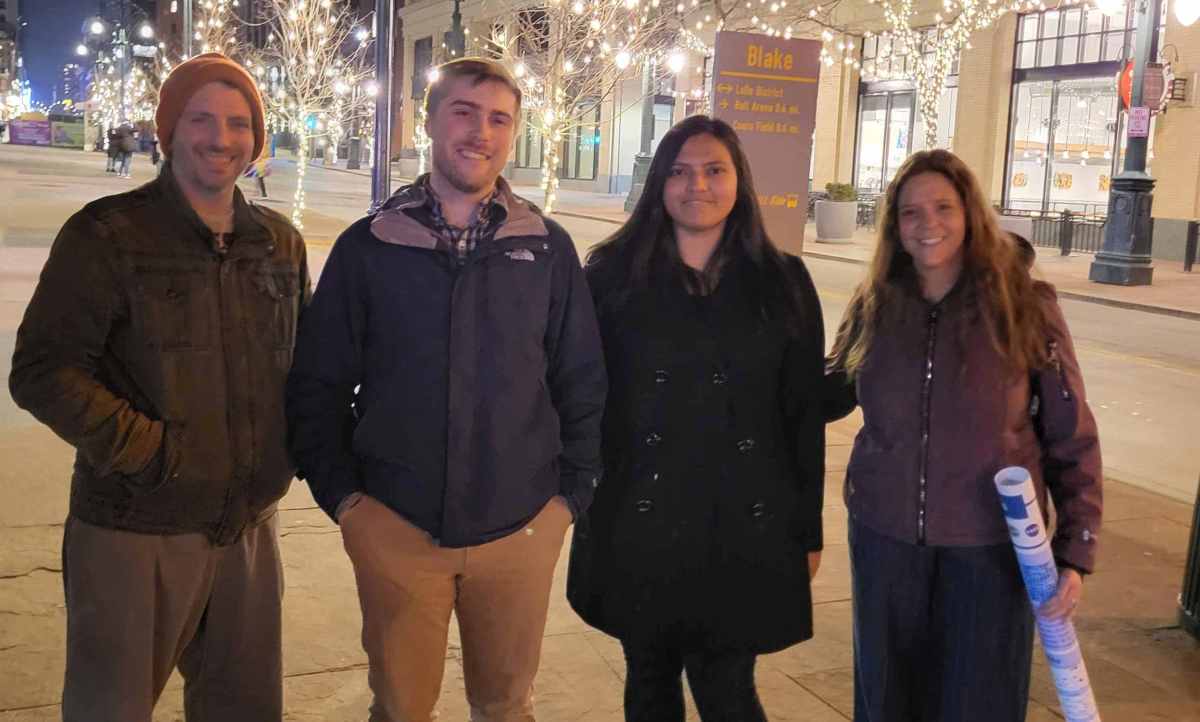
AMS meeting as a group!Jan 13, 2023The whole group came out to Denver for the American Meteorological Society annual meeting. Archana gave an e-poster on cloud water organic acid measurements. Chris gave an oral presentation on cloud water chemical modeling. Adam gave a poster characterizing laboratory generated nanoplastic particles. I gave an overview talk on the CHACHA field project and another talk on the strategy and preliminary results from the CAREER funded work. Sarah Woods gave an oral presentation on the microphysical properties of Arctic lead clouds. Great to be in person together! |
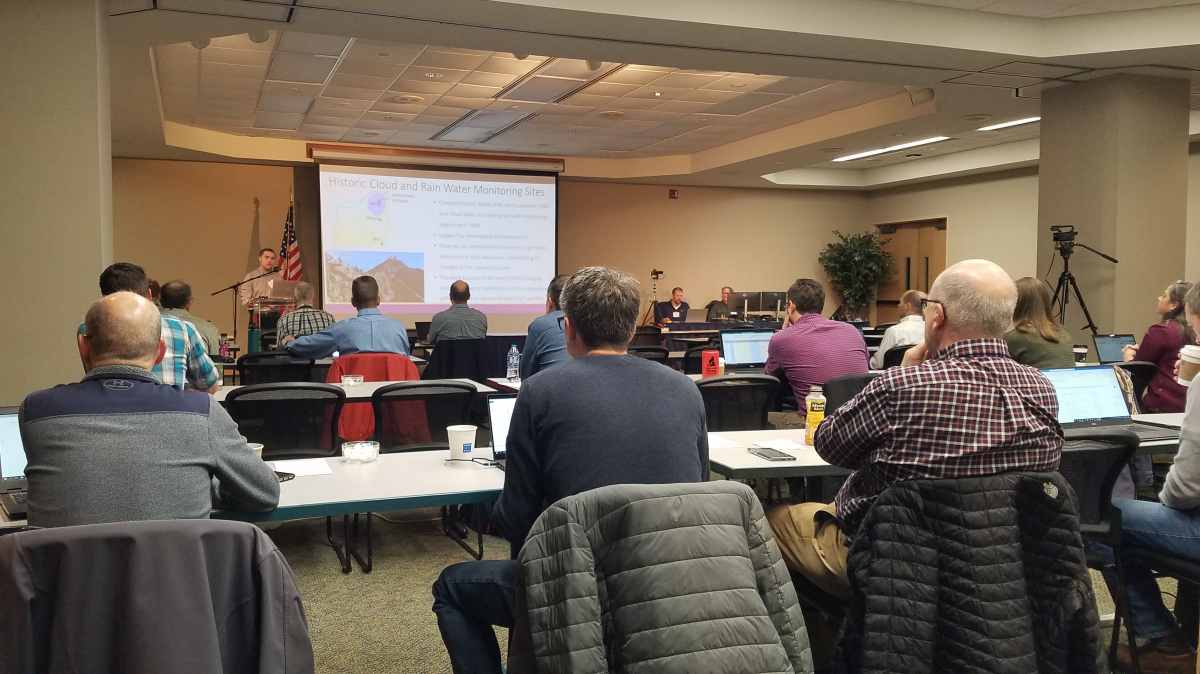
NADP meeting 2022Nov 18, 2022Chris gave a presentation at the National Acid Deposition Program (NADP) meeting with 2022 Theme: "Monitoring for a Sustainable Future" in Knoxville, TN and won the best student presentation award! This meeting was a great opportunity to connect with researchers studying PFAS and a great opportunity to visit the Great Smoky Mountains and see the research being conducted there. |
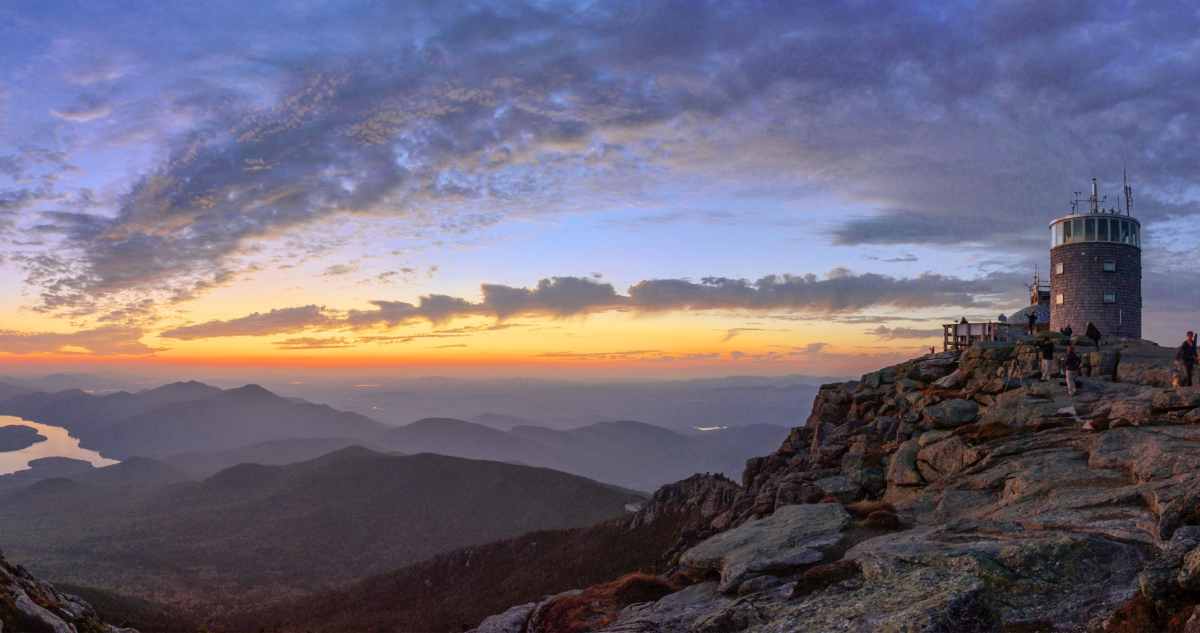
WFM 50th Anniversary CelebrationNov 2, 2022ASRC celebrated the 50th anniversary of the WFM Summit Research Observatory, also known as the 'Silo Building' built in 1971, with our long-time research partners at the NYS Department of Environmental Conservation (DEC). UAlbany President Havidan Rodriguez, DEC Division Director for Air Resources Chris Lalone, ASRC director Chris Thorncroft, and long-time steward of the WFM atmospheric monitoring program Jim Schwab talked about the historical importance of WFM, and I followed with my vision for the future of research at WFM. These were my remarks. |
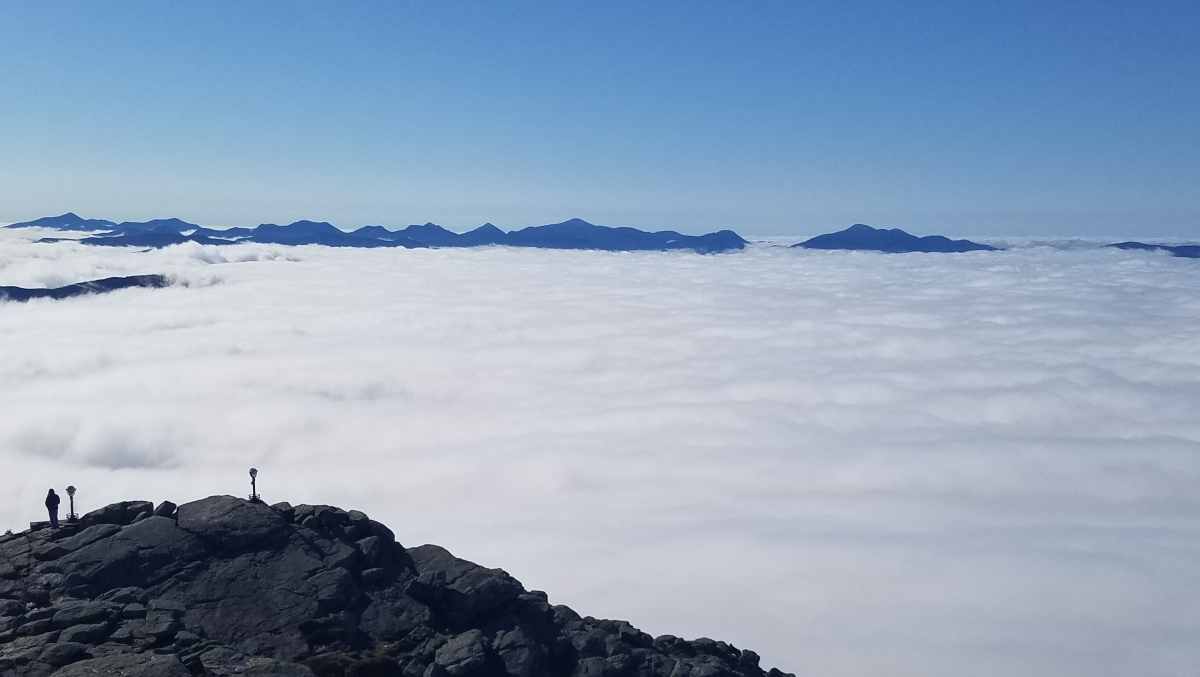
Nearing the end of SummerSep 21, 2022As Summer turns to Fall, the summit of WFM is more likely to peek out over top of the boundary layer into the free troposphere, where the air is decoupled from the surface and more likely to encounter pollutants that have been transported a long distance from their sources. Since the clouds typically encountered at WFM sit at the top of the boundary layer, that means there are more likely to be "undercast" days with clouds stretched out below as far as the eye can see. Under these conditions, we are unable to sample the clouds, but we get the rare opportunity to sample the air above them. and what a view! |
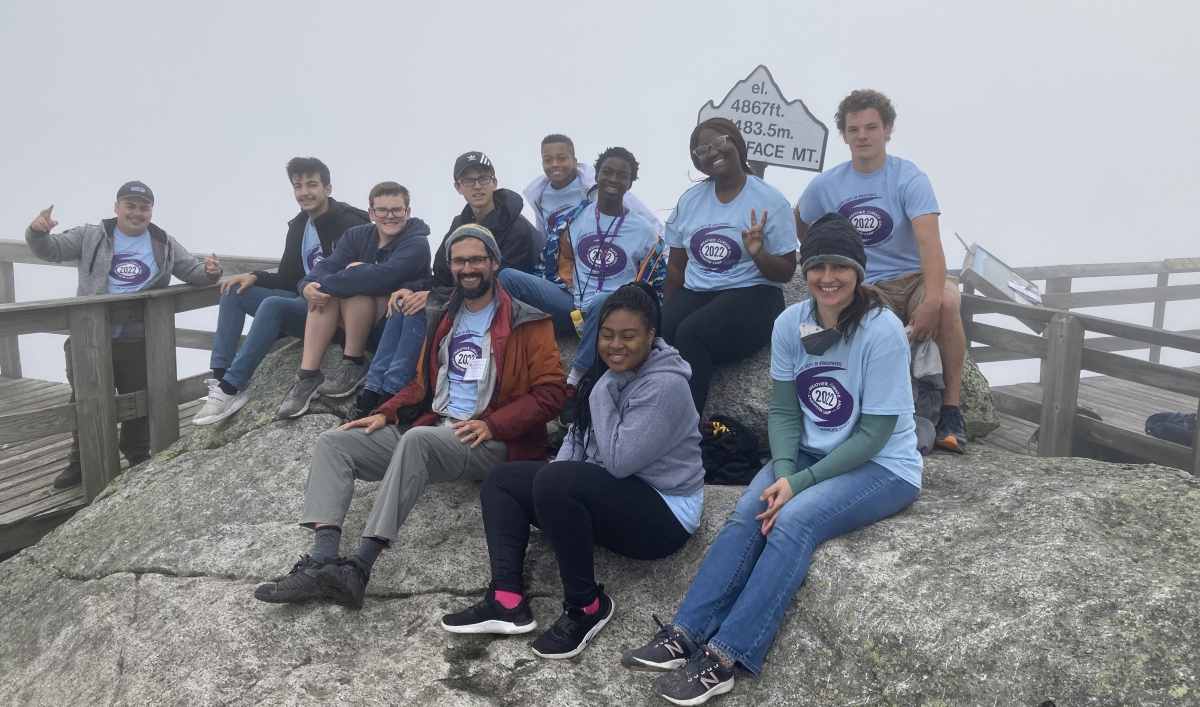
Summer Camp 2022Aug 22, 2022Justin Minder and I just wrapped up our second UAlbany Weather, Climate & Chemistry Camp, a free summer day camp for local high school students. We had 10 students participating this year and what a great group. |
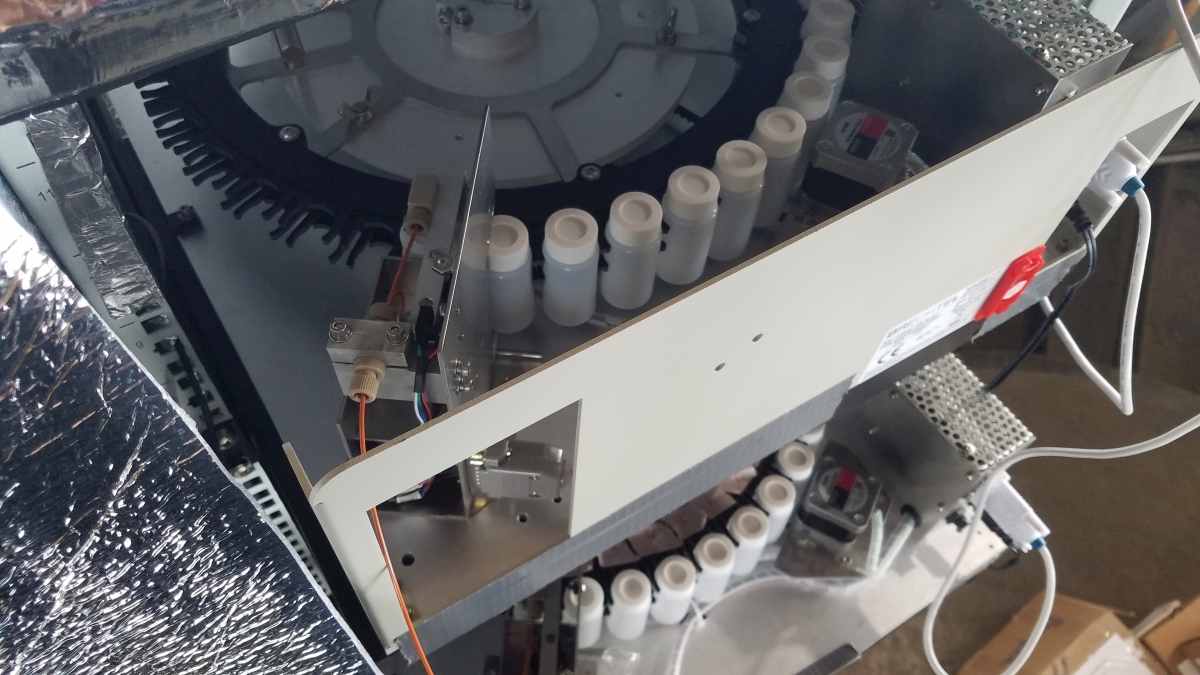
Set up of New Instrumentation at the summit of WFM is Almost CompleteJul 12, 2022We now have two autocollectors accumulating samples from the Particle into Liquid Sampler (PILS), one that is connected to the new PM10 inlet when in clear-air and another one that is connected to the GCVI inlet when in-cloud. This enables us to collect aerosol and cloud droplet residual samples during the same 6 hour period when conditions are variable that can be compared directly against each other. Since there is a small hatch to the top floor of the silo building (accessible by ladder), equipment that is too large cannot be used up there unless it is put together piece by piece. The autocollectors for the PILS are quite large and I could not find a refrigerator to house them that would also fit through the hatch. To get around this, I decided to build my own refrigerator to my own specifications using thermoelectric coolers. It's still in progress, but seems like it'll work nicely. This will help us preserve the samples from the moment they are collected until they are removed the summit and frozen, and ultimately analyzed in the laboratory. |
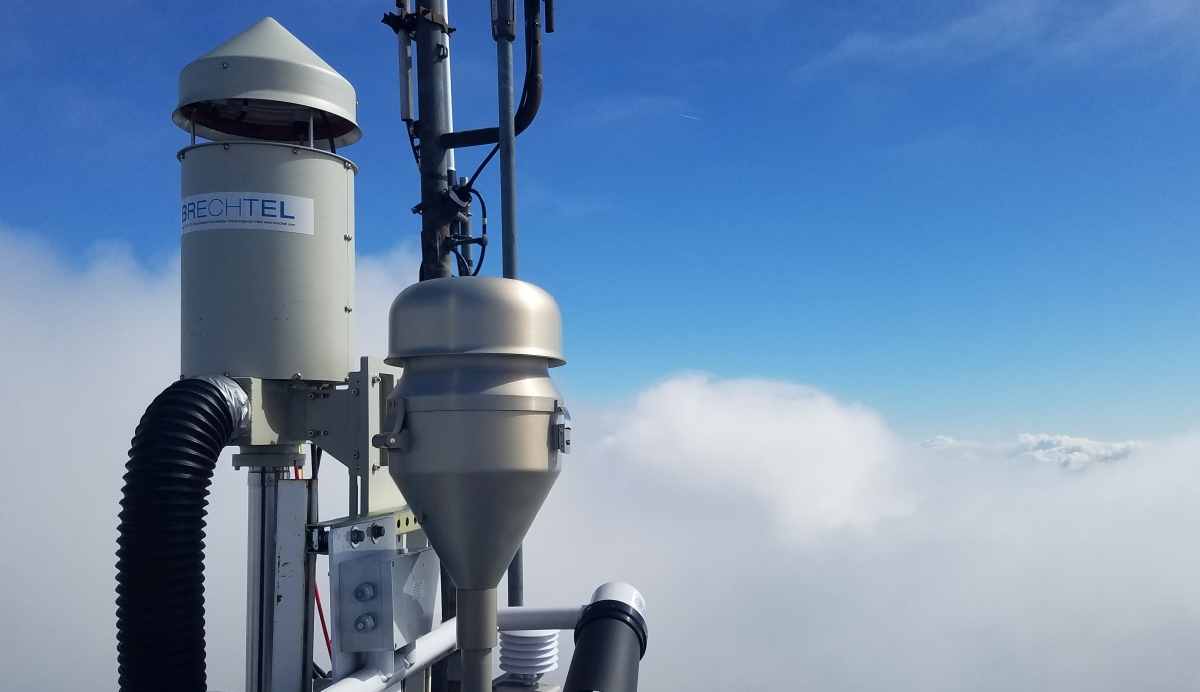
New high volume PM10 inletJun 24, 2022Having continuous flow instruments downstream of the GCVI inlet means that we need to switch them over to a different inlet when in clear-air since the GCVI only samples in-cloud. In our first summer of sampling we used a PM10 inlet we already had (which samples aerosol particles smaller than 10 micrometers in diameter, but was not designed for the high flow required for some of our instruments like the PILS). This week we installed a new aerosol inlet to support up to 20 L/min sample flows, so now we can measure both cloud droplet residuals (in-cloud) and aerosols (when in clear-air). |
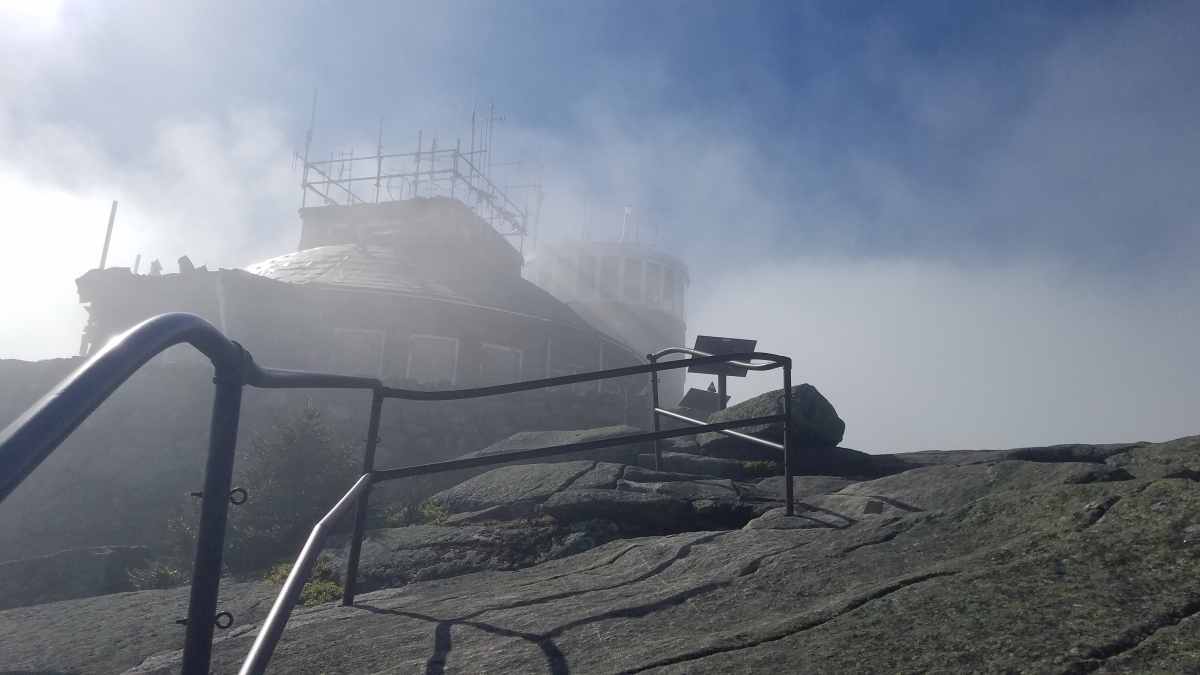
GCVI & PILS back up and running!Jun 16, 2022The GCVI equipment on the roof of the ASRC research observatory at WFM was reinstalled in early June, since it had been removed after roof renovations last summer. We got everything back in order, including a functional airspeed measurement after replacing the CVI electronics board. Chris also got the PILS deployed again, sampling behind the GCVI inlet when in-cloud and sampling from a HEPA filter when in clear-air. The deployment was much quicker than expected - we're getting better at this! |
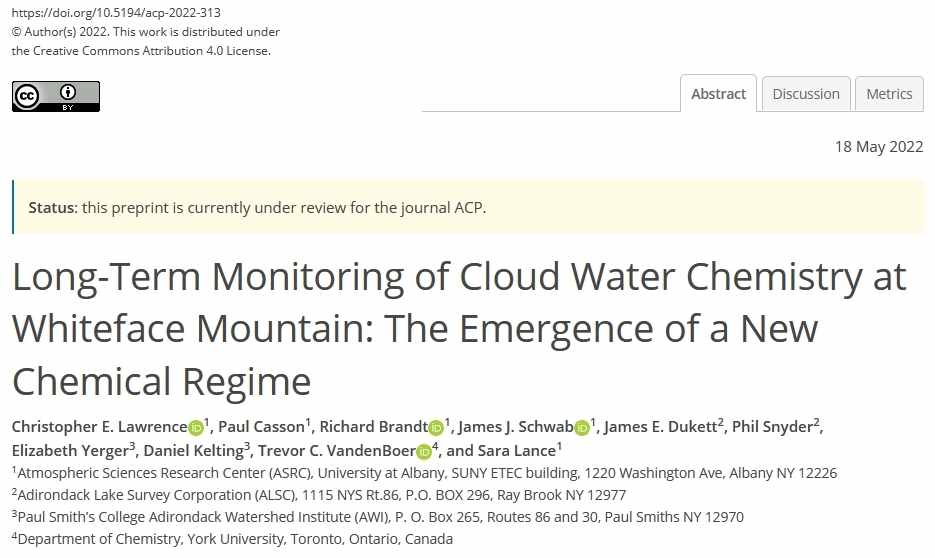
Long-Term Trends Paper Submitted for Peer Review!May 18, 2022Short summary of the manuscript: Atmospheric aqueous chemistry can have profound effects on our environment, as illustrated by historical data from Whiteface Mountain (WFM) that was critical for uncovering the process of acid rain. The current study updates the long-term trends in cloud water composition at WFM for the past 28 years (1994–2021). We highlight the emergence of a new chemical regime dominated by organics and ammonium, quite different from the highly acidic regime observed in the past, but not necessarily “clean”. |
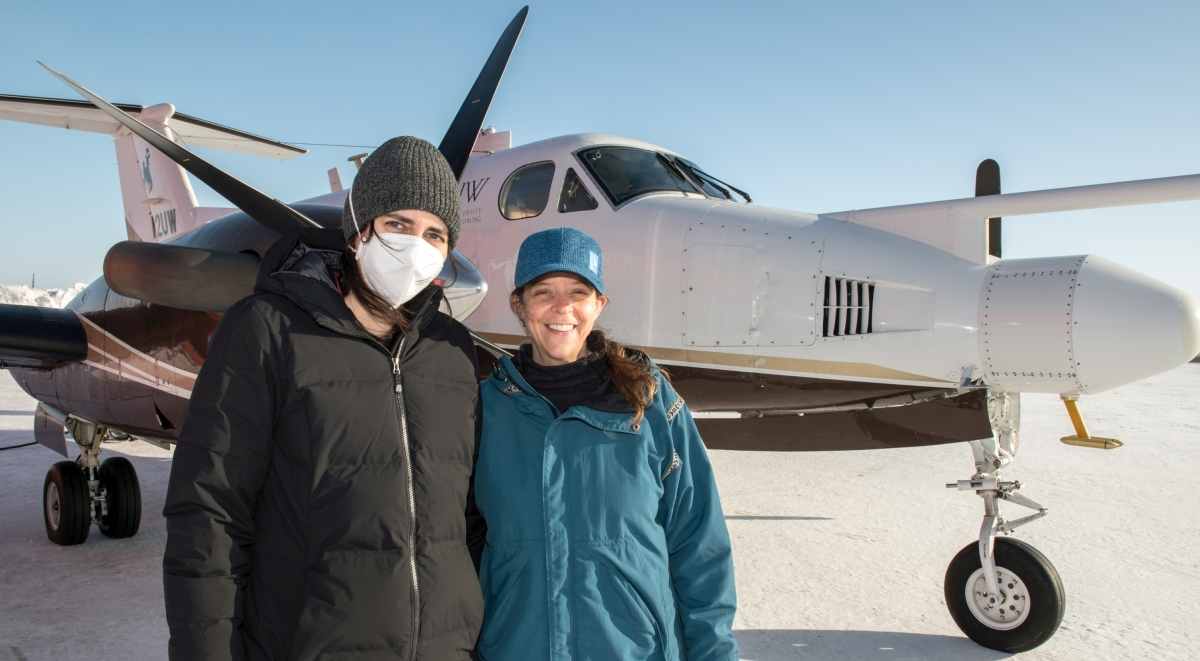
CHACHA comes to its conclusionApr 16, 2022After 33 research flights with the UWyo King Air and 26 research flights with the Purdue Duchess, spanning from February 21 to April 16, the CHACHA campaign comes to a close. Special thanks to those working tirelessly in the field through the entire project (Sarah Woods, Daun Jeong, Natasha Garner, Kris Hadjny, Bob Kaeser and Nathaniel Brockway) and to pilot Tom Drew who ended up flying most of our cloud flights! Check out UAlbany's press release for more details. Photo credit: Chris Rodgers (Sara Lance and Sarah Woods) |
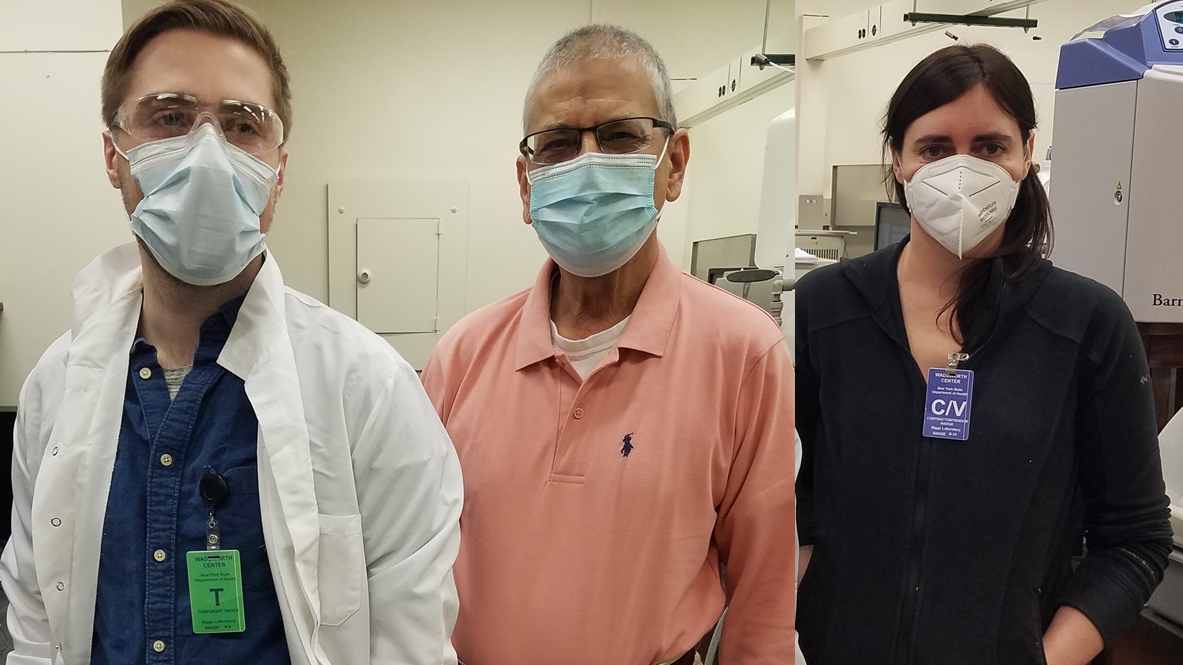
Collaboration with School of Public HealthApr 6, 2022We were finally able to begin a collaboration with Dr. Khwaja, who wrote a seminal paper on chemical characterization of cloud water samples collected at WFM during 3 summer cloud episodes in 1987, including organic acid measurements. As part of this collaboration, Chris and Archana are learning from Dr. Khwaja and Dr. Mirza Hussain best practices for measuring organic acids in cloud water samples collected at WFM in 2020 and 2021. We will compare our results to additional historical WFM measurements from Dr. Khwaja's lab from the late 1980's through the early 2000's that have not yet been published. |
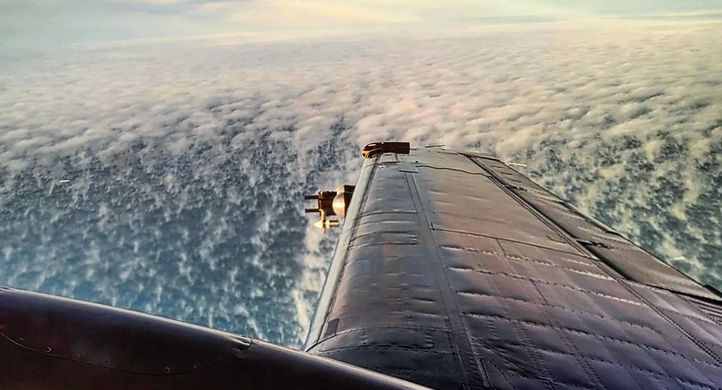
CHACHA commences!Feb 27, 2022Our first flight sampling Arctic lead clouds within the shallow Arctic boundary layer (~600ft altitude) showed cloud droplet concentrations up to 250/cc and occasional ice particles up to 1 mm in diameter. This type of cloud has a dearth of in-situ observations because of the challenge of accessing their location (low over the Arctic ocean). We were lucky to be able to fly into them when an unseasonal shift in the sea ice broke open exposing the ocean surface (in February!) We had planned to focus on cloud processing in the latter half of the project, but we took the opportunity to sample some lead clouds during the first King Air research flight, partly because they were right there in the vicinity of BRW (Utqiagvik)! Photo credit: Sarah Woods |
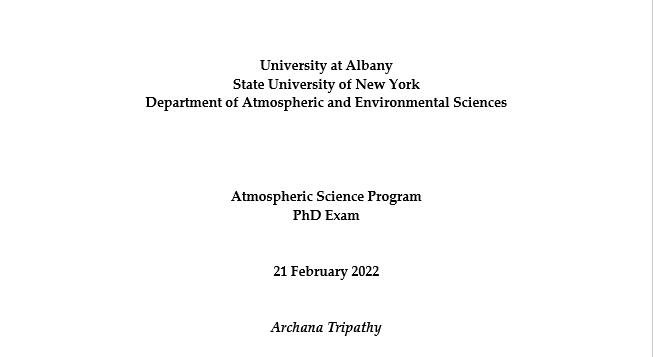
Archana passes her written qualifying examFeb 21, 2022The two day exam comprised two questions posed by each of her committee members: Aubrey Hillman, Jim Schwab, Fangqun Yu and I. |
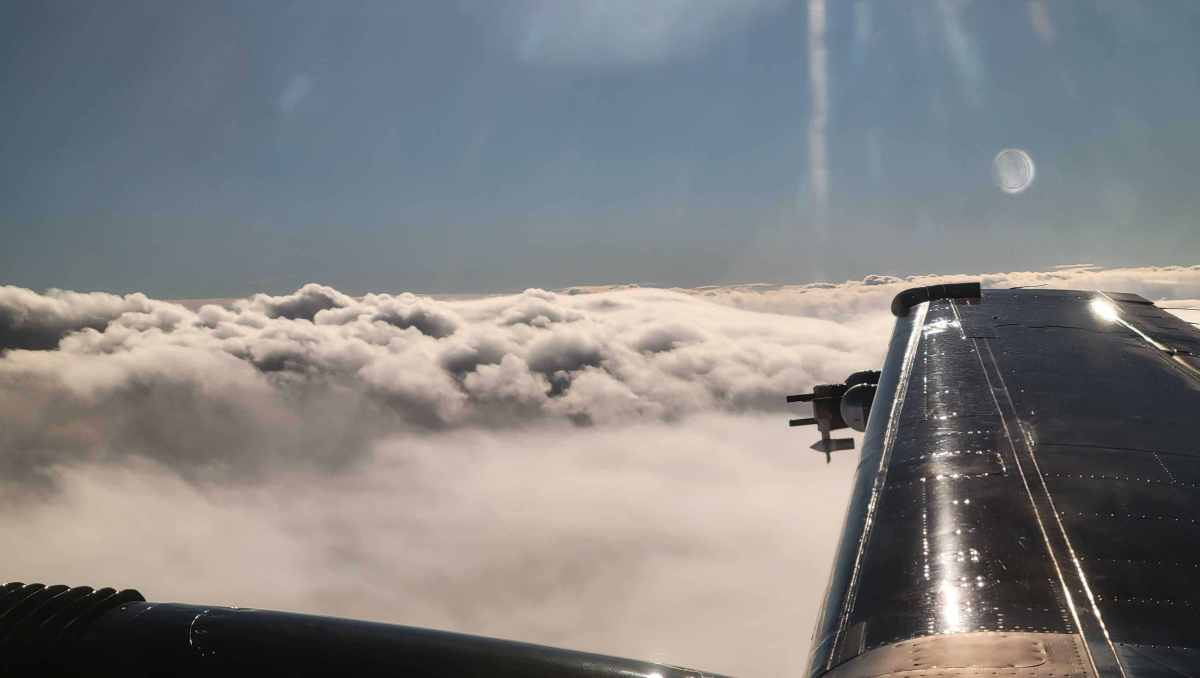
CHACHA Test Flights in WyomingFeb 6, 2022We successfully sampled cloud droplets with our new counterflow virtual impactor (CVI) inlet for the first time on the University of Wyoming King Air! While conditions were not optimal for testing the CVI (too many large ice particles), the measurements we obtained during the test flights give us confidence that the CVI and downstream instruments are working well and we are ready to start sampling clouds in the Arctic. We were not able to fully test this new equipment until now, because there is no substitute for a flight test when it comes to an instrument like this. A lot of work was required to get to this point and we finally made it! Photo credit: Sarah Woods |
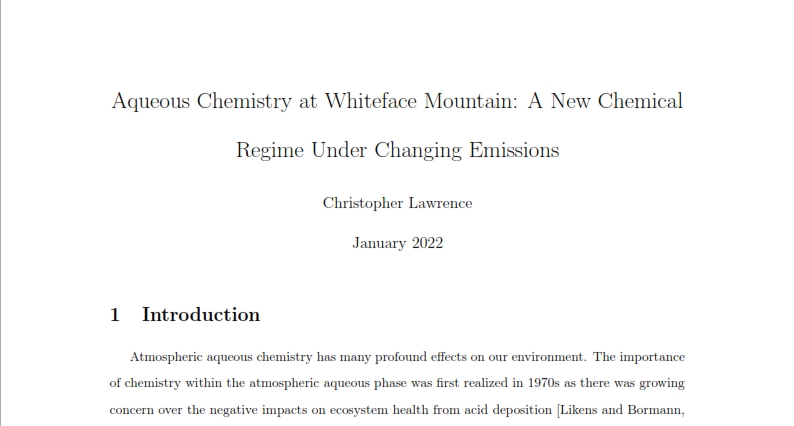
Chris passes his PhD prospectusJan 7, 2022Christopher Lawrence passed his oral qualifying exam. The committee (comprised of Jim Schwab, Fangqun Yu, Justin Minder, Mary Barth and I) met with Chris for about 45 minutes following his public presentation and met privately for another 45 minutes to discuss Chris' progress, and no major deficiencies in his prospectus or research plan were identified. This is the last major milestone in the PhD degree program until the dissertation and defense. |
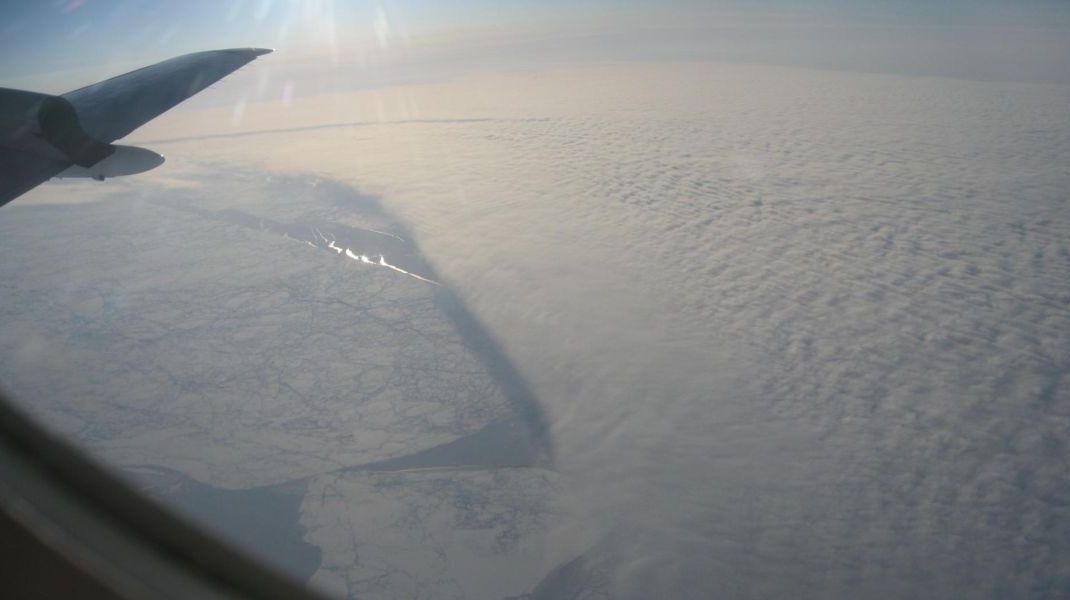
CHACHA website now liveDec 27, 2021The new CHACHA website describes our Arctic field project this spring. The photo to the left is one I took from the back of the NOAA P-3 during the ARCPAC campaign in 2008, showing the boundary layer stratocumulus clouds with sea ice and open leads below. Warming in the Arctic is happening faster than almost anywhere else on Earth and changes in the clouds could be playing an important role. The CHACHA campaign is focused on understanding halogen chemistry in the lower Arctic atmosphere, which may be changing as sea ice melts exposing more of the Arctic ocean to the atmosphere. However, changing chemistry also often has important implications for climate change, including potential changes to the clouds. |
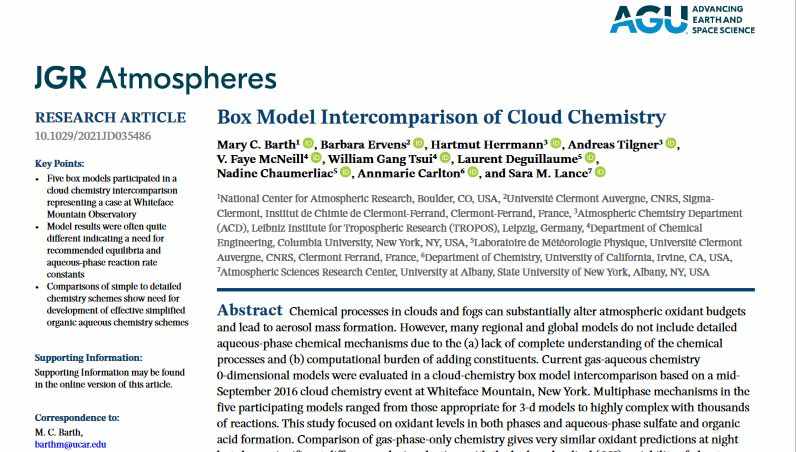
Mary Barth publishes in the Journal of Geophysical ResearchOct 14, 2021This paper, with our collaborator Mary Barth, investigates heterogeneous chemistry using five different box models, to better understand photochemical processes impacting gas and cloud water chemistry, constrained by measurements made at Whiteface Mountain in 2016 during the Cloud Chemistry Workshop. Substantial differences between the model results indicate that much more works needs to be done to confidently and accurately evaluate chemical processes taking place in clouds, including additional measurements of gas phase partitioning to the aqueous phase and aqueous chemical rate constants. |
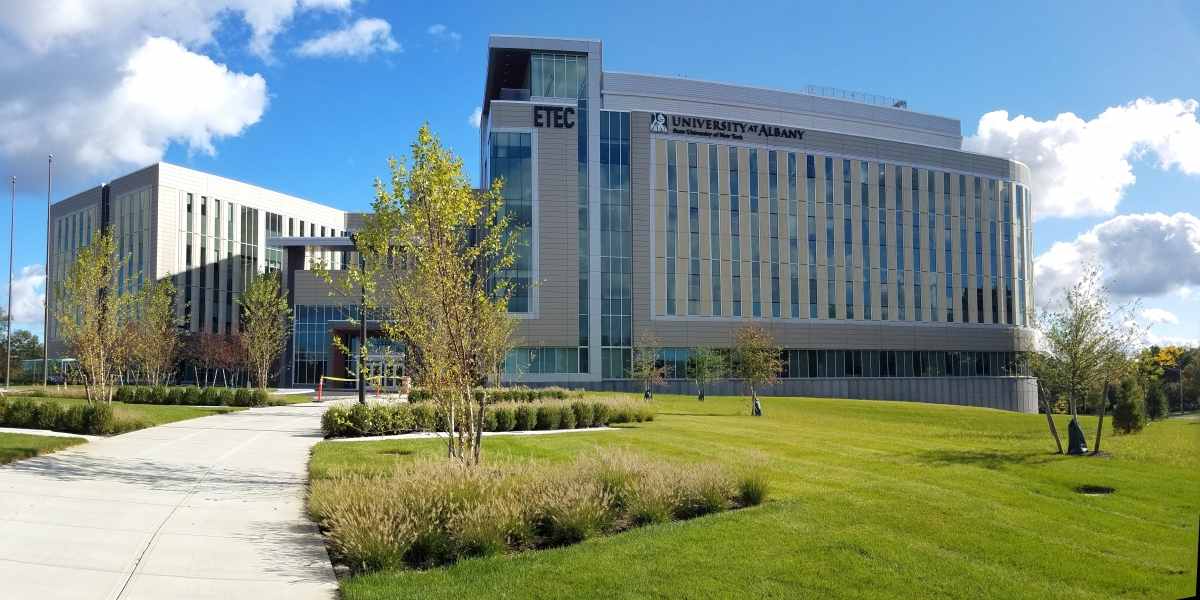
ASRC moves into ETECSep 30, 2021The Atmospheric Sciences Research Center (ASRC) moved into the new ETEC building, alongside the Dept of Atmospheric & Environmental Sciences (DAES) and the College of Emergency Preparedness, Homeland Security and Cyber Security (CEHC), the NY State Mesonet and the National Weather Service (NWS), among others. |
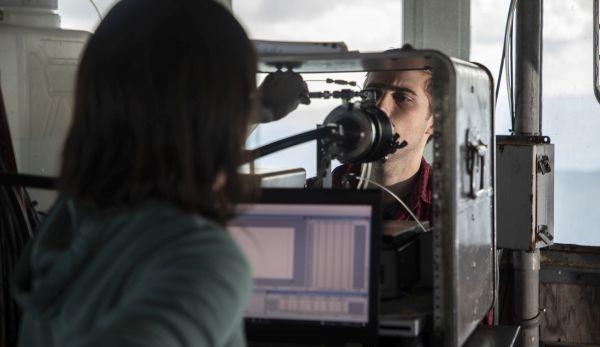
UAlbany Press ReleaseSep 14, 2021UAlbany Media & Marketing did a press release to celebrate the NSF CAREER project that really started ramping up at WFM this summer and the NASA graduate student fellowship Chris was awarded recently. The article also notes that NYSERDA has supported cloud water chemistry research for many years. |
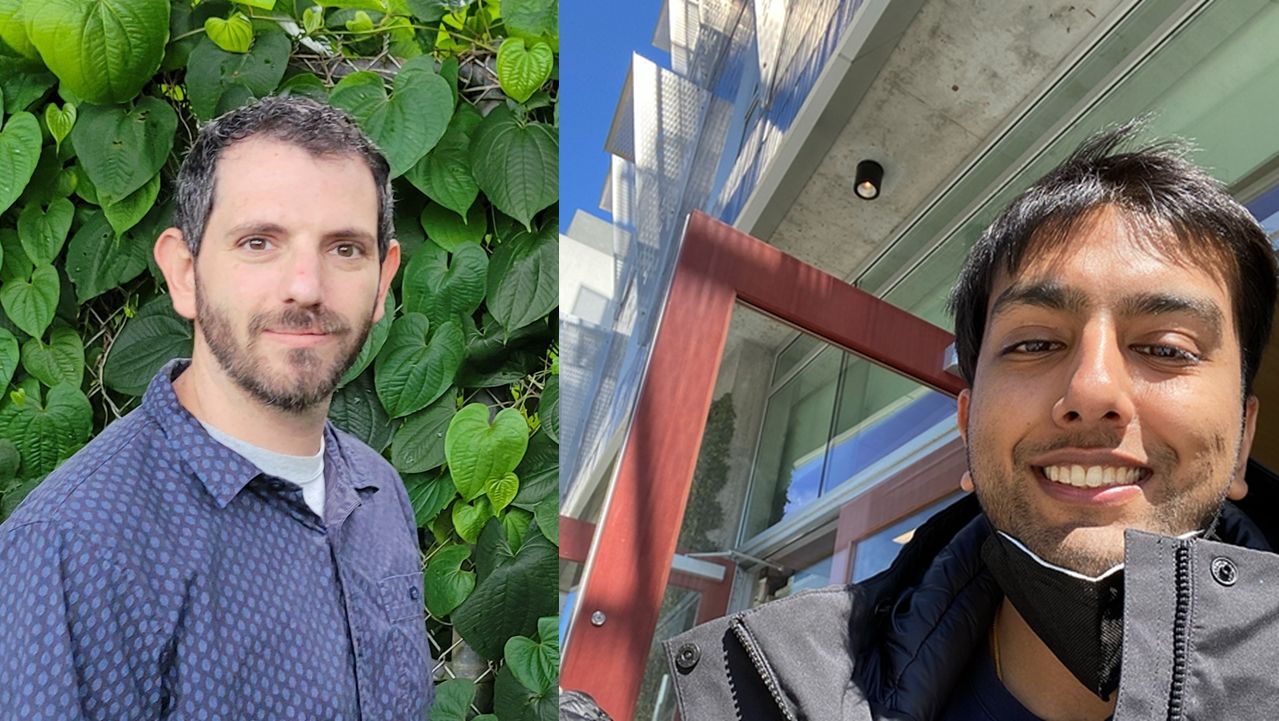
Two new graduate students join the group!Aug 28, 2021Vishal Bagadia and Adam Deitsch began their coursework at UAlbany this Fall, just as we are transitioning to the new ETEC building. They both participated in our remote group meetings during the summer and we are excited to actually meet them in person now! |
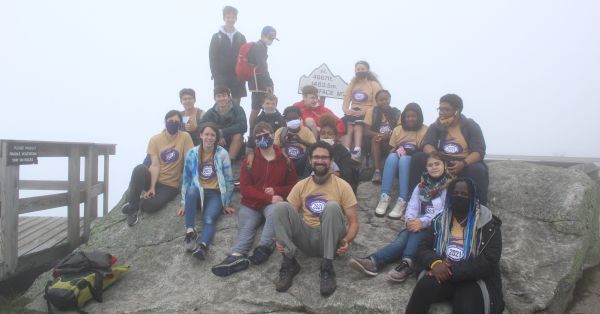
Summer Camp 2021Aug 20, 2021Justin Minder and I just wrapped up our first UAlbany Weather, Climate & Chemistry Camp, a free two week summer day camp for local high school students. What a great program to be part of! |
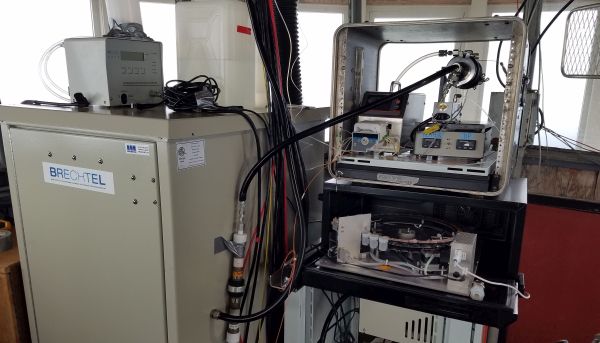
PILS DeployedJul 30, 2021This past week at Whiteface Mountain was a very productive trip for Chris and I. Fred helped me discover why the GCVI had been blowing fuses and acting erratically, and luckily it was an extremely easy fix! Chris then deployed the PILS behind the GCVI for the first time on Friday. I learned that one of our particle sizing instruments was not communicating perfectly with the software on Friday, too, but that is a relatively minor issue. The important thing is that Chris can start collecting PILS samples of the cloud droplet residuals next week, which we can then compare with the cloud water samples. This should give us several good weeks of measurements before the end of the season this year. Then all the instruments will need to be packed up so that the roof can be replaced before the cold is again upon us. |

Very Hazy DayJul 20, 2021Smoke from wildfires in the western US and south central Canada appeared to be strongly impacting air quality across New York State today, as evidenced by substantially reduced visibility and increased black carbon concentrations at Whiteface Mountain. The cloud water filter was the blackest we have ever seen it, and the cloud water conductivity and acidity the highest it has been in years. Chris obtained his first PILS samples from the Whiteface Mountain Lodge (at the base of the mountain), which will provide additional information about the aerosol chemical composition. Chris measured total organic carbon concentrations of 1-3ppm in the PILS samples, corresponding to approximately 8-24 micrograms per cubic meter of aerosol organic carbon (preliminary estimate) |
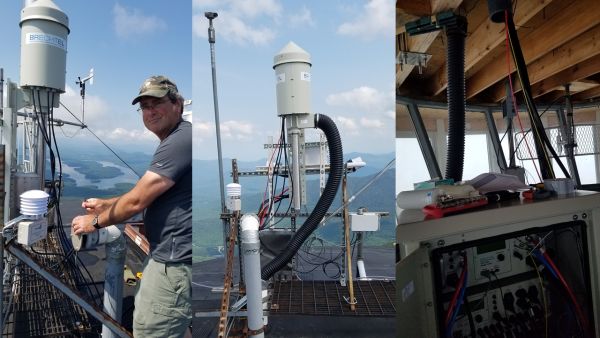
GCVI installedJul 16, 2021Archana, Paul, Rich and I finished installing the GCVI this week, and obtained our first cloud droplet residual measurements on Friday! This entailed mounting the wind tunnel and meteorological sensors on the roof, creating a new roof penetration and connecting all the power, data cables and flow tubes to the control modules inside the building. So far we've only obtained number concentrations. Next step will be to obtain the particle size distribution and chemical composition of the cloud droplet residuals, after we figure out why we keep blowing fuses. Chris spent the week getting our Particle into Liquid Sampler (PILS) ready for deployment to obtain samples for subsequent chemical analysis. |
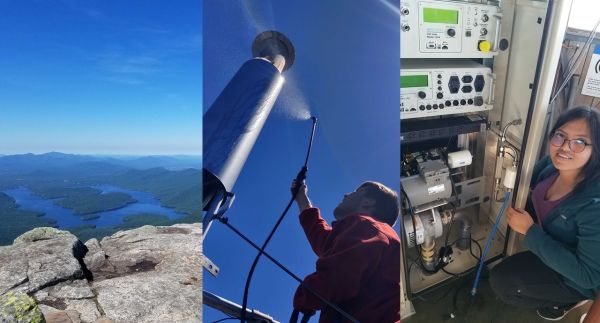
Progress in the FieldJun 25, 2021Archana, Chris and I came up to Whiteface Mountain again this week to continue deployment of the GCVI and aerosol instruments at the summit research observatory, and work on improving the cloud water collection efficiency. There were several sunny days to conduct spray tests of the cloud water collector and work on installing the GCVI wind tunnel on the roof. Significant progress was made, but still more to be done. During ascent today, we noticed what looked to be an elevated smoke layer coming in from the west, which might be attributed to a number of ongoing wildfires in the western and southern U.S. |
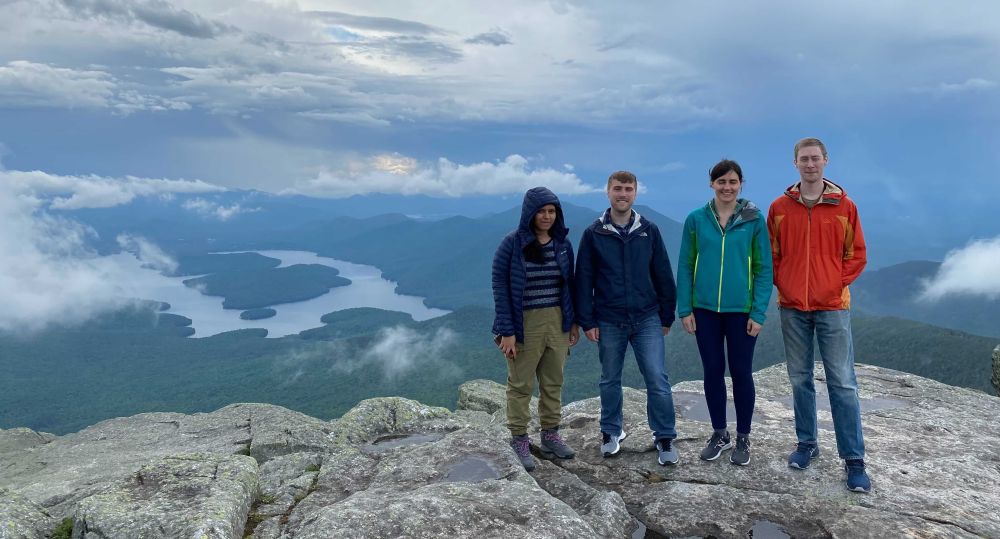
First field deployment as a groupJun 18, 2021We went up to Whiteface Mountain as a group for the week, largely to deploy our new GCVI (Ground-based Counterflow Virtual Impactor). All 600 lbs of it. We had to disassemble much of it and take it up to the summit via elevator over multiple trips, carrying the individual components up the remaining ~40ft of spiral staircase to the top floor of the silo building. Chris also installed headspace in the cloud water collection system to remove air bubbles, and Joseph started setting up the FFSSP again so that we can measure cloud droplet size distributions, which will be needed to characterize the performance of the GCVI. Next task: GCVI reassembly! |
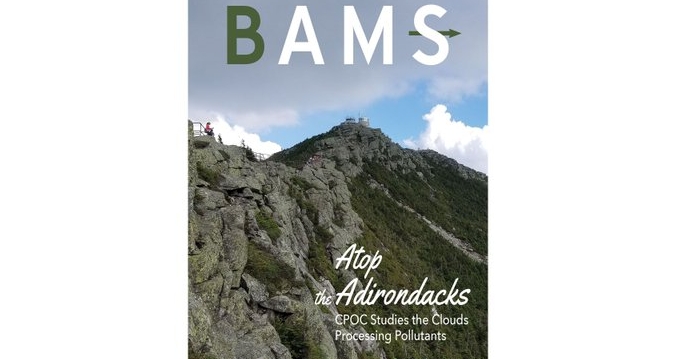
Cover image on BAMS features the CPOC pilot studyJun 2, 2021This volume 102 of the Bulletin of the American Meteorological Society highlights the CPOC overview paper published late last year. |
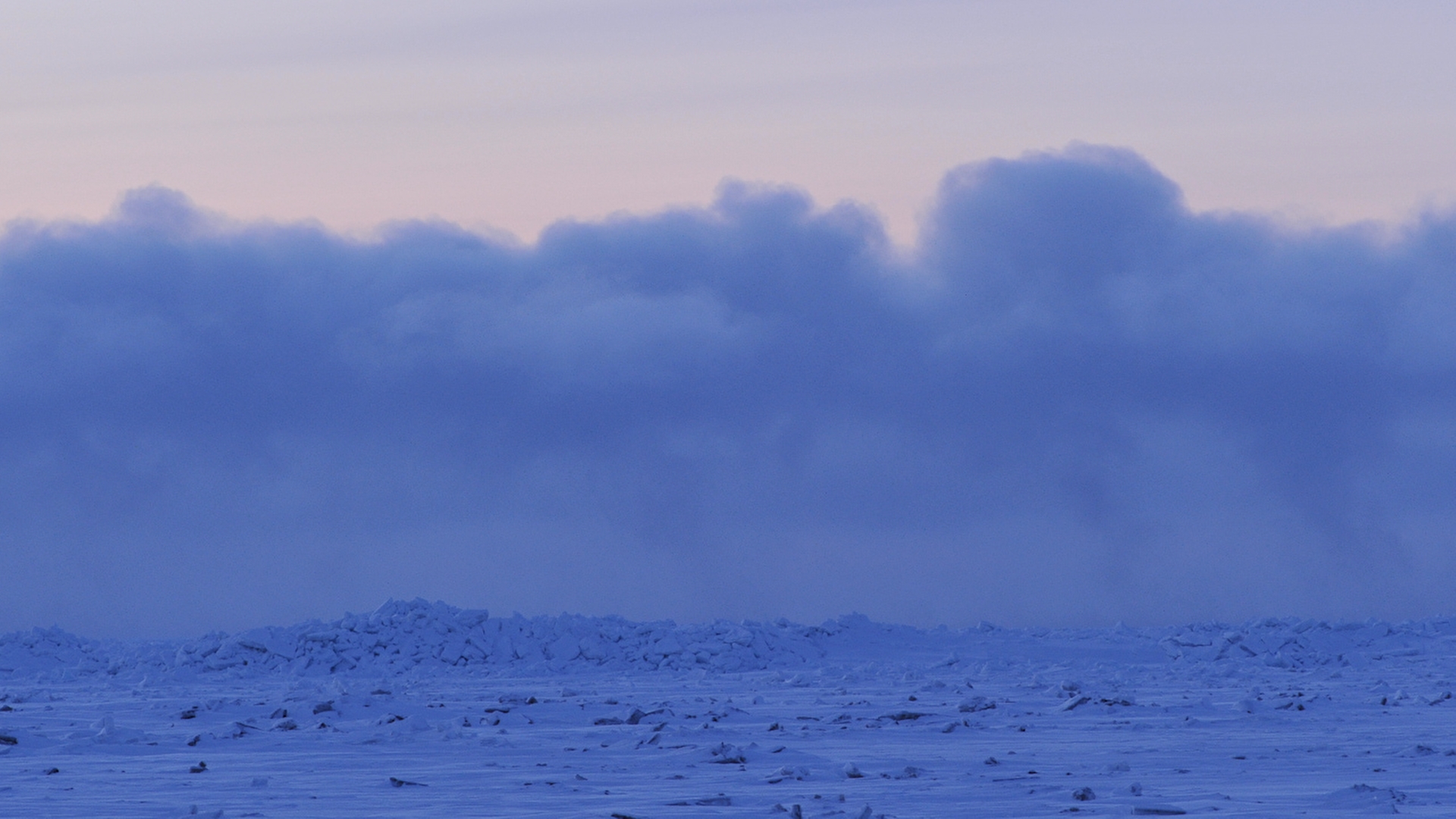
CHACHA workshop beginsMay 23, 2021Our CHACHA planning workshop began with remote sessions, this first one focusing on Hypothesis #1 regarding sea ice leads, sea spray aerosol, halogen chemistry and clouds. |
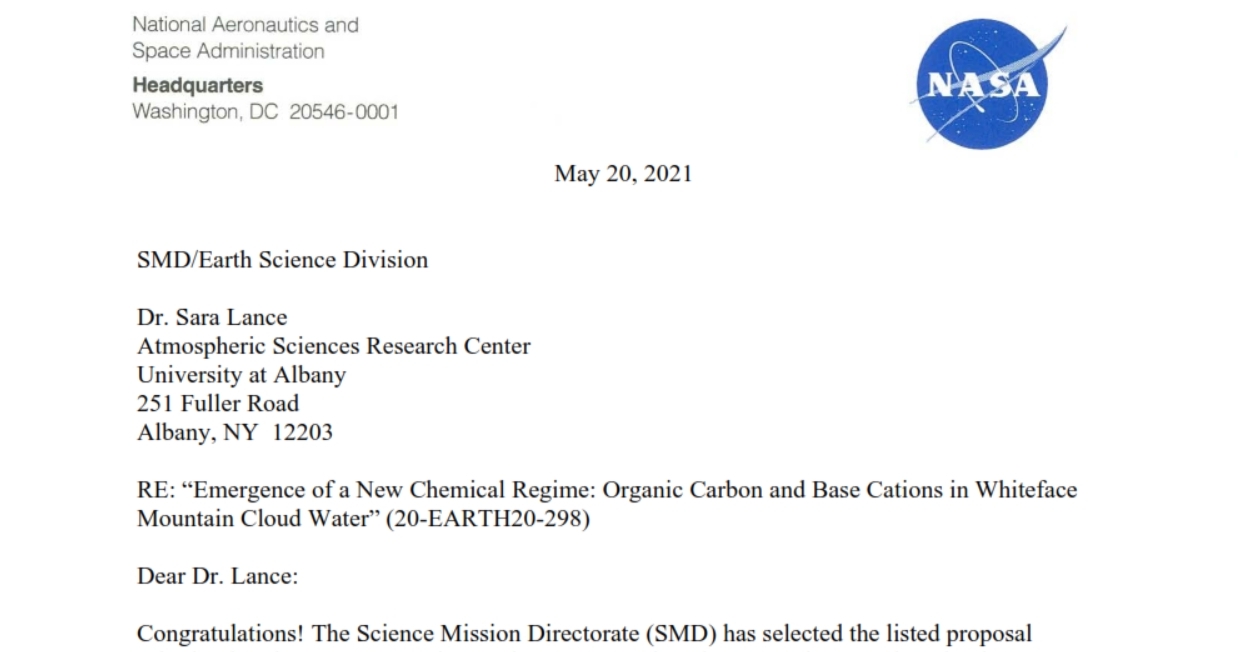
Chris is awarded a NASA FINESST Fellowship!May 20, 2021Chris receives notice that he will be awarded a NASA graduate fellowship, which will cover his stipend and tuition for up to 3 years, and incentivizes collaboration with researchers at NASA to incorporate use of other in-situ and remote sensing observations in our analysis of cloud water and aerosol composition in New York State, particularly relating to biomass burning emissions and transport. |